
About UsThe Numismatic Bibliomania Society is a non-profit organization devoted to the study and enjoyment of numismatic literature. For more information please see our web site at coinbooks.org SubscriptionsThose wishing to become new E-Sylum subscribers (or wishing to Unsubscribe) can go to the following web page link MembershipThere is a membership application available on the web site Membership Application To join, print the application and return it with your check to the address printed on the application. Membership is only $20 to addresses in the U.S., $25 for First Class mail, and $30 elsewhere. For those without web access, write to: David M. Sundman, Treasurer
AsylumFor Asylum mailing address changes and other membership questions, contact David at this email address: dsundman@LittletonCoin.com SubmissionsTo submit items for publication in The E-Sylum, just Reply to this message, or write to the Editor at this address: whomren@gmail.com BUY THE BOOK BEFORE THE COIN |
- WAYNE'S WORDS: THE E-SYLUM MARCH 22, 2015
- KOLBE & FANNING FIXED PRICE LIST OF RUSSIAN BOOKS
- NEW BOOK: ENCYCLOPEDIA OF OBSOLETE PAPER MONEY, VOL. 5
- NEW BOOK: EARLY RUSSIAN COINS, 1353-1553
- BOOK REVIEW: SYLLOGE NUMMORUM SASANIDARUM – UZBEKISTAN
- BOOK REVIEW: KEEP THE CHANGE
- BOOK REVIEW: COINED
- QUERY: 'I HULL' EDGE INSCRIPTION ON TIME CAPSULE MEDAL
- MASSACHUSETTS STATE HOUSE TIME CAPSULE EXHIBIT
- ARTHUR A. HOUGHTON WINS 2015 ANS HUNTINGTON AWARD
- NOTES FROM E-SYLUM READERS: MARCH 22, 2015
- DR. HENDERSON AND WILLIAM ASHBROOK
- NEW MEDAL DISPLAY AT PHILADELPHIA MUSEUM OF ART
- ISAAC NEWTON DESIGNED QUEEN ANNE'S CORONATION MEDAL
- LORD ASHCROFT MOVES TO KEEP MUNRO MEDALS IN NEW ZEALAND
- MARY MARTIN'S 'SOUND OF MUSIC' TONY AWARD MEDAL
- ROYAL MINT UNVEILS NEW 2017 POUND COIN DESIGN
- ARTICLE TIES ANNE BINGHAM TO U.S. COINAGE
- SELECTIONS FROM DAVE WNUCK'S MARCH 2015 INVENTORY
- A GOBRECHT DOLLAR RETURNS HOME
- HENRY P. KENDALL FOUNDATION COLLECTION PREVIEW
- WILLOW TREE SILVER COINS
- MORE ON FOOD STAMP CHANGE TOKENS
- DISCOVERY SHEDS LIGHT ON BOX AND 'OPIUM' DOLLARS
- 2015 WORLD MONEY FAIR TECHNICAL FORUM
- CONFESSIONS OF A GOLD BUYER
- THE ARTIST, THE CONMAN AND THE $15 MILLION FRAUD
- QUERY: GEORGETOWN OBSOLETE BANKNOTE INFO SOUGHT
- NEW IRAN BANKNOTE REMOVES NUCLEAR SYMBOLS
- NEW 20 EURO PROMOTED WITH TETRIS GAME
- NUMISMATICA GENEVENSIS NOVEMBER 2014 SALE SUMMARY
- NEW YORK'S FIRST BANK ROBBERY
- DESIGNER COIN BANKS
- FEATURED WEB PAGE: THE ANS COLLECTION AT HATHITRUST
Click here to access the complete archive
To comment or submit articles, reply to whomren@gmail.com
WAYNE'S WORDS: THE E-SYLUM MARCH 22, 2015

Recently several subscribers reported not receiving their issues. Many of them are Comcast subscribers. I asked our support folks for help, and they wrote: "Comcast was indeed blocking us due to a false report of "spam" from the server. It has now been removed, and email is flowing through to Comcast subscribers." So hopefully that problem is fixed. Thanks for your patience, folks.
New subscribers this week include: Bernard Nagengast, courtesy of Jeff Starck; Tom McCain, courtesy of Warner Talso; Mike Young, G. Peano, and Brian Patterson. Welcome aboard! We now have 1,834 subscribers
This week we open with an update from Kolbe & Fanning, two new books, and three book reviews. Other topics include the Massachusetts State House time capsule, Dr. Henderson, Isaac Newton, Lord Ashcroft, Tony Award medals, Iran's new banknote and New York's first bank robbery.
To learn more about Russian metrology, Russian-American Company notes, shrunken banknotes, Banca Transylvania, Admiral Maarten Harpertzoon Tromp, box and opium dollars, designer coin banks and the impact of crystallization parameters of the AgCu 92.5 alloy ingots on surface quality of proof quality coin blanks, read on. Have a great week, everyone!
Wayne Homren
Editor, The E-Sylum
KOLBE & FANNING FIXED PRICE LIST OF RUSSIAN BOOKS
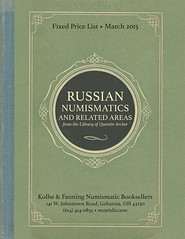 Kolbe & Fanning Numismatic Booksellers have published a new fixed-price list focusing on
Russian numismatic literature. The 300-item PDF catalogue can be downloaded or viewed on the Kolbe & Fanning website at www.numislit.com.
Kolbe & Fanning Numismatic Booksellers have published a new fixed-price list focusing on
Russian numismatic literature. The 300-item PDF catalogue can be downloaded or viewed on the Kolbe & Fanning website at www.numislit.com.
The catalogue includes material from the library of Quentin Archer, generally consisting of modern books, periodicals and auction catalogues on Russian coins and medals. The list also includes material on closely related topics, such as Eastern European, Central Asian, and Islamic numismatics. Many standard works are included, a number of which are difficult to locate in the United States. Most of the items are available for $100 or less. Several notable rarities are included, however, such as:
Lot 135: Kaufman’s 1906 work on Russian metrology.
Lot 186: Minns, Scythians and Greeks (1913 first edition).
Lot 234: a rare 1857 Carlsruhe edition of Schubert on Russian coins and medals.
Lot 284: Valentine’s very rare work on the coins of the Golden Horde.
Other titles include works by Bitkin, Brekke, Davenport, Diakov, Federov-Davydov, Gaidukov, Grand Duke Georgii Mikhailovich, Ianin, Ilyin, Mel’nikova, Mets, Oreshnikov, Pakhomov, Potin, Severin, Shchukina, Sotnikova, Spasskii, Talvio, Tolstoï, Uzdenikov, Zaitsev, Zander and others.
Periodicals include many rarely offered works published in limited quantities by Soviet academic institutes, as well as more familiar journals published by the Hermitage and other institutions.
Auction catalogues include sales by Aurea Numismatika Praha, Bank Leu, Alexander Basok, Adolph Cahn, Christie’s, Galerie des Monnaies, Giessener Münzhandlung, Dieter Gorny / Gorny & Mosch, Adolph Hess, Kreisberg & Cohen, Dmitry Markov, NASCA, Renaissance Auctions, Hans M.F. Schulman, J. Schulman, Superior, and others.
Only one copy is available of most works, so do not delay in placing orders. It is recommended that orders be placed by phone at (614) 414-0855 or via email to df@numislit.com.
Additional Russian numismatic books (and works on other subjects) are available for immediate sale on the Kolbe & Fanning website at www.numislit.com.
NEW BOOK: ENCYCLOPEDIA OF OBSOLETE PAPER MONEY, VOL. 5
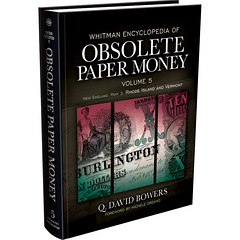 Whitman Publishing announces the upcoming release of volume 5 of the Whitman Encyclopedia of Obsolete Paper Money, by Q. David
Bowers. In 544 pages it covers the early bank currency of the states of Rhode Island and Vermont. The book will debut on the Fourth of
July, 2015, and before then can be pre-ordered from booksellers and hobby shops nationwide and online (including at www.Whitman.com), for
$69.95. It can also be borrowed for free as a benefit of membership in the American Numismatic Association, through the Dwight N. Manley
Numismatic Library.
Whitman Publishing announces the upcoming release of volume 5 of the Whitman Encyclopedia of Obsolete Paper Money, by Q. David
Bowers. In 544 pages it covers the early bank currency of the states of Rhode Island and Vermont. The book will debut on the Fourth of
July, 2015, and before then can be pre-ordered from booksellers and hobby shops nationwide and online (including at www.Whitman.com), for
$69.95. It can also be borrowed for free as a benefit of membership in the American Numismatic Association, through the Dwight N. Manley
Numismatic Library.
The Whitman Encyclopedia of Obsolete Paper Money is a multiple-volume study of currency issued from 1782 to 1866, before the modern era of National Banks and the Federal Reserve. Over the course of these decades more than 3,000 state-chartered banks issued their own paper money, which facilitated much of the nation’s day-to-day commerce.
In volume 5, Bowers, a well-known historian and past president of the American Numismatic Association, gives the history of 104 Rhode Island and Vermont towns and cities, as well as of every bank in those towns that issued this uniquely American currency. Each note is studied, and hundreds are pictured in full color, with information on grading, rarity, values, significant auction results, advice for collectors, and more.
“There are countless Rhode Island and Vermont bank notes sitting in collections, just waiting to be properly identified,” Bowers says. “Some of them are rare and worth thousands of dollars. Many others are very affordable, and a collector can build a significant set without spending a fortune.”
Active collectors, researchers, dealers, historians, and other experts have volunteered their time and knowledge to help create this new encyclopedia series. The state editor for Rhode Island and Vermont is noted New England specialist C. John Ferreri.
Michele Orzano, a paper-money expert and senior editor of Coin World, wrote the foreword to volume 5. “Bowers has clearly fallen head over heels for the allure of obsolete notes,” Orzano says. “Though the banks that issued them are long gone, the notes themselves help trace the roots of goods and services provided to Americans in the 1700s and 1800s. With the Whitman Encyclopedia, collectors can enjoy the designs and history contained in these pieces of paper.”
Earlier volumes of the Whitman Encyclopedia of Obsolete Paper Money include an overview of the field, and detailed coverage of the New England states of Connecticut, Maine, New Hampshire, and Massachusetts. Future volumes will cover the South Atlantic states, the Mid-Atlantic states, the American Midwest, the District of Columbia, and territories.
Collectors, dealers, historians, and hobbyists interested in assisting on future volumes may contact Whitman Publishing at Obsoletes@Whitman.com.
Whitman Encyclopedia of Obsolete Paper Money
Volume 5: New England, Part 3—Rhode Island and Vermont
By Q. David Bowers; edited by C. John Ferreri; foreword by Michele Orzano
ISBN 0794843263 Hardcover, 8.5 x 11 inches, 544 pages
Full color
Retail $69.95 U.S.
For more information, or to order, see:
www.Whitman.com
To read the earlier E-Sylum articles, see:
NEW BOOK: WHITMAN ENCYCLOPEDIA OF OBSOLETE PAPER MONEY
(www.coinbooks.org/esylum_v17n21a03.html)
NEW BOOKS : ENCYCLOPEDIA OF OBSOLETE PAPER MONEY, VOLS 3 & 4
(www.coinbooks.org/esylum_v17n44a03.html)
NEW BOOK: EARLY RUSSIAN COINS, 1353-1553
Authors Dzmitry Huletski, Konstantin Petrunin, and Alexander Fishman write:
 With a great pleasure we introduce the first complete catalogue of early Russian coins. Russian edition of
the book (2013) already became a standard reference for Russian medieval coinage at many European auctions and coin stores.
With a great pleasure we introduce the first complete catalogue of early Russian coins. Russian edition of
the book (2013) already became a standard reference for Russian medieval coinage at many European auctions and coin stores.
14-16th century Russian coins - a large chunk of European medieval numismatics- are set out in very clear layout - by the regions and rulers, covering period from first post-Mongol issues to the end of Yoke in 16th century.
The anticipated catalogue "Early Russian Coins, 1353-1553" is a study of the wonderful and fascinating world of the earliest Russian coinage of the feudal and fragmented Russian states, never before published outside Russia and almost unknown in the West.
Before the later 14th century, Russia was an assembly of small independent states, plagued by infighting and lingering under the overlordship of the Mongols. Starting in the 14th century and in under a century most of these Russian states were united under the rule of Moscow, partially through treaties and other political means and partially through heavy-handed military action. By the late 15th century the unification was complete, and a large single state with a capital in Moscow was formed.
Many of the feudal Russian states minted coins of their own starting in the 14th century, using new and original designs and naming their own rulers. The coinage, almost unknown in the West, exhibits a fascinating diversity, with many hundreds of types in silver and bronze produced. These early coins include imitations of the Mongol (Golden Horde) dangs, coins combining Russian elements and Islamic elements and, finally, a huge range of purely Russian coins showing a surprising variety of designs including biblical themes and verses, mythological themes and animals, numerous violent scenes of fighting, stabbings, decapitations and other things one might expect from medieval coins. Other strange things found on these coins are designs showing Alexander of Macedon, scenes of homage, scenes of coin minting and ever-present Russian inscriptions naming the ruling Dukes.
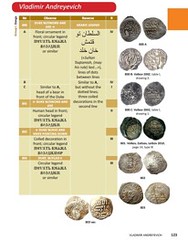

This catalogue includes descriptions and images of many hundreds of coins, from the inception of the native Russian coinage to the eventual unification of types under the Vasily Ivanovich of Moscow (1505-1533). Coins of the Russian states which were not conquered by Moscow (such as Lithuania and Red Russia) are also included this book. The relative rarity ranking for all the listed coins is also given, which should be of immense help to any collector of medieval coins.
The information is based on the most modern numismatic research available, but is presented in a simple-to-use way, aiming to introduce this fascinating coinage to the wide circle of both collectors and researchers.
This book is an English edition of "Russian Coins 1353-1533" of 2013 which has now become a standard catalogue for Russian medieval coins being actually a first publication of such scale since 19th century catalogues.
English edition!
444 full colour pages.
Soft cover.
For more information, or to order, see:
http://wirecoins.de/erc/
Eric Schena adds:
For many years the only reference on the topic was the 1896 Oreshnikov book which, until it was reprinted in the 1990s was impossible to find. I had to go to the Library of Congress and spent several hours copying their copy.
THE BOOK BAZARRE
BOOK REVIEW: SYLLOGE NUMMORUM SASANIDARUM – UZBEKISTAN
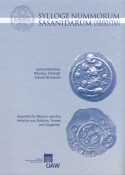 Larissa Baratova, Nikolaus Schindel, Edvard Rtveladze, Sylloge Nummorum Sasanidarum
Usbekistan. Sasanidische Münzen und ihre Imitationen aus Bukhara, Termes und Chaganian. Österreichische Akademie der Wissenschaften,
Vienna, 2012. 199 p., comprising 47 plates, 21.5 x 30.3 cm, images in black and white, hardcover. ISBN: 978-3-7001-6945-1. 69 euros.
Larissa Baratova, Nikolaus Schindel, Edvard Rtveladze, Sylloge Nummorum Sasanidarum
Usbekistan. Sasanidische Münzen und ihre Imitationen aus Bukhara, Termes und Chaganian. Österreichische Akademie der Wissenschaften,
Vienna, 2012. 199 p., comprising 47 plates, 21.5 x 30.3 cm, images in black and white, hardcover. ISBN: 978-3-7001-6945-1. 69 euros.
The view of numismatics has broadened over the course of the last decades. Of particular high interest to researchers are the fringe areas on which only little research has been done. Thus, it is time for new Sylloge volumes. The Numismatic Commission of the Austrian Academy of Sciences published the first volume of the Sylloge Nummorum Sasanidarum (SNS) in 2003. After the collections of the Bibliothèque nationale de France, the State Museums of Berlin and the Kunsthistorisches Museum Vienna, this volume focuses on material which researchers find difficult to access. It comes from Uzbekistan.
Uzbekistan, the country located between Kazakhstan and Turkmenistan with the cities of Samarkand und Tashkent, is more reminiscent of Arabian Nights than of numismatics. However, on the threshold of ancient and medieval times, this country issued a coinage with a range much bigger than that of the Old World, which was stricken with the migration of the peoples back then.
The Sasanids had their silver drachmae produced in neighboring Merv. They became the model for the local coinage of tribes and clans in Central Asia. Sogdiana and the Hephtalites in Tocharistan are particularly important in this respect. These coins are a major source for reconstructing the history of Central Asia. They have not – or not sufficiently – been published so far. The latest Sylloge volume, written in collaboration with the Institute for Archaeology of the Uzbek Academy of Sciences, makes this material accessible at last.
The 647 coins, displayed on 47 plates, are preceded by a detailed commentary. It begins with the history of research done on this subject so far and an overview of the collections that have been accessed for this study. That is followed-up by a thorough discussion of the material. This discussion is very important. After all, contrary to Greek or Roman coins, no reliable order of the material has yet been established, and likewise not every attribution is beyond any doubt. Published in this volume is the current state of research which is further progressing. The authors want the series and interpretations put forward to be understood as a preliminary result and a contribution to the ongoing academic discussion.
As such, this volume is quite useful. It conveys information on a numismatic area to which most catalog authors concede victory. It provides insights into one of the most exciting stages of the history of mankind which we have only recently begun to reconstruct - with numismatics playing a decisive role. The contributors, Michael Alram and Rika Gyselen, deserve a lot of credit for dealing so thoroughly with this subject that is often dismissed as a fringe area.
An order for the Sylloge Nummorum Sasanidarum volume on Uzbekistan, as for any other SNS volume, can be placed at the homepage of the Austrian Academy of Science Press.
For more information, or to order, see:
http://verlag.oeaw.ac.at/Sylloge-Nummorum-Sasanidarum-Usbekistan
To read the complete article, see:
Sylloge Nummorum Sasanidarum – Uzbekistan
(www.coinsweekly.com/en/News/4?&id=3325)
BOOK REVIEW: KEEP THE CHANGE
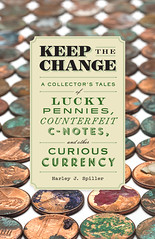 On
a recent business trip I had a chance to read Harley Spiller's book on the plane. Keep the Change is a quick read, and I would
recommend it to E-Sylum readers. While not exactly a numismatic book, it covers many of the same interesting numismatic side roads
we often travel here - counterfeits, altered coins and currency, political overstamps, banknote origami and other paper money art.
On
a recent business trip I had a chance to read Harley Spiller's book on the plane. Keep the Change is a quick read, and I would
recommend it to E-Sylum readers. While not exactly a numismatic book, it covers many of the same interesting numismatic side roads
we often travel here - counterfeits, altered coins and currency, political overstamps, banknote origami and other paper money art.
For example, in the "Illustrated Taxonomy" at the end of the book is an entry on shrinking paper money. Who knew? Many thanks to the author and Jaime Nelson at the Princeton Architectural Press for forwarding images and text for this article.
![010_Money_ch10_41[1B]_jh_p97](https://farm8.staticflickr.com/7588/16264673713_c1632e7df3.jpg)
Shrinking: The cloth used to make US Banknotes can be shrunk. Artists using a proprietary heat and water process created a bill I purchased at the Whitney Museum of American Art gift shop in 1997. The shrunken single is thicker and stiffer than standard dollars, but, like all US banknotes, it still weighs exactly one gram. Alas, I failed to record the artists’ names, and the Whitney’s archive has no information. Coins can also be shrunk via elaborate processes; see http://www.capturedlightning.com/frames/shrinkergallery.html
![06_Money_ch6_21[1C]_jh_p60](https://farm9.staticflickr.com/8736/16884663045_80553a113c_m.jpg)
Here's a nicely done example of folded money art by Gay Merrill Gross titled George Washington Framed.
![04_Money_ch4_16[1A]_jh_p44](https://farm8.staticflickr.com/7622/16262282124_b5b5fccc06.jpg)
Above is a selection of dollar bills rubber stamped by artist Peggy Diggs in 2003, asking questions about wealth and poverty.
The earlier E-Sylum article (linked below) provides some more background on the book, which covers damaged and mutilated coins as well as paper money. It's a fun book, and Spiller clearly comes by his love of coins honestly - at the back of the book is a Children's Hospital receipt for his childhood examination after swallowing a nickel.
To view a video about the book, see:
Keep the Change by Harley J. Spiller, Book Trailer (https://vimeo.com/119891906)
To read the earlier E-Sylum article, see:
NEW BOOK: KEEP THE CHANGE (www.coinbooks.org/esylum_v18n03a07.html)
BOOK REVIEW: COINED
“Nothing had an effect on people like money,” recalled a Stanford neuroscientist who once experimented with scanning people’s brain activity while they played high-stakes financial games. “Not naked bodies, not corpses. It got people riled up. Like food provides motivation for dogs, money provides it for people.”
When it comes to money, we are basically animals. This is something we may know in our hearts, but it’s still shocking to see it made manifest in real life, as Kabir Sehgal did while working at J. P. Morgan in 2008. When the market crashed, revealing the supposedly complex system to be little more than a series of rusty pulleys and weights, it “exploded my perception of money,” Sehgal writes. “I was alarmed with the damage wrought by the financial crisis, and I had difficulty grasping how it could have happened in the first place. I rode the No. 6 train and saw grown men crying while they carried cardboard boxes of office supplies. I remember watching on television the misery in the eyes of Americans who had lost their homes.” The shock of the experience prompted Sehgal to embark on a quest to “understand money,” its origins, history and why it makes us behave the way we do.
This is an ambitious endeavor, one that crosses into multiple disciplines and has been taken on by greater scholars than a J. P. Morgan vice president (Sehgal was promoted after the crisis). John Maynard Keynes even had a name for this particular brand of intellectual treasure hunting — “Babylonian madness” — coined after he became “absorbed to the point of frenzy” trying to pin down the origins of currency in Asia. (And researching monetary history was his full-time gig!).
Dave Ginsburg writes:
This Sunday’s issue of The New York Times’ Book Review is a “special issue” devoted to “The Secret Life of Money,” among which is a review of a book titled Coined: The Rich Life of Money and How its History Has Shaped Us by Kabir Sehgal. The review, written by a woman who suffers the misfortune of being a “contributing editor” at New York magazine, includes these comments: “. . .in the latter half of the book, where he introduces a gang of numismatists – coin collectors – whose hobby in the social food chain probably ranks somewhere below gold bugs and just above Civil War re-enactors. Sehgal is respectful, even affectionate toward these oddballs. He understands, and perhaps identifies with their mission – to understand history, and human beings, by looking closely at their money.”
Hmppfh!
Joel Orosz writes:
Ouch! We've been served. Our hobby's image clearly nears to be burnished.
Perhaps it is time for the networks to do for oddball numismatists what they've done for oddball nuclear physicists with The Big Bang Theory. How about a sitcom called The MS-70 Theory?
She called us oddballs! It's mostly true, of course, but she should have been more tactful! As I pointed out to my wife, "It could be worse--you could be married to a Civil War re-enactor!
To read the complete article, see:
‘Coined,’ by Kabir Sehgal
(www.nytimes.com/2015/03/22/books/review/coined-by-kabir-sehgal.html?ref=books&_r=1)
QUERY: 'I HULL' EDGE INSCRIPTION ON TIME CAPSULE MEDAL
We have had an incredible opportunity at the MFA with regard to the Massachusetts State House time capsule and I wanted to make sure the E-Sylum readers know it is now on public display here for a brief time. The display opened on Wednesday, March 11 and will run until April 22, 2015.
I am sure that many of the E-Sylum readers will want to see it, and I definitely want to get the word out about the exhibition. But another reason for writing is that I want to share a mystery with the group and see if anyone can help shed more light on it.
The time capsule itself really has two distinct components. The first is the silver plaque, coins, and medal placed under the cornerstone in 1795 by Samuel Adams, Paul Revere, and William Scollay. This original deposit was later discovered accidentally, and a brass box was made to preserve what was found and to allow for a group of additions intended to represent that moment in the summer of 1855. That's the second component. A fairly accurate accounting of the discovery and reburial can be found in the Freemason’s Monthly Magazine for October 1855 (p.367). It’s available on Google Books.
One of objects from the 1795 group is a Washington "Born Virginia" medal (Baker 60). When my colleague Pamela Hatchfield was removing some wax that had been applied to it in 1855 she discovered a tiny inscription on the edge (all of the numismatic material had been "cleaned" in 1855 with acid and then coated with an acidic wax which was corroding them).
On one side were carefully engraved initials HI (or IH) and on the opposite side, what looked (under a microscope) like a crudely engraved number. Eventually we realized it was a name (it was upside down when we first tried to read it). It seems very clearly to be: “I Hull”. It is so small that it is hard to see without magnification and its certainly possible that it went unnoticed in both 1795 and 1855.

So we are now wondering if this could be Isaac Hull—the future Captain of the USS Constitution. He would have been about 22 years old at the time of the laying of the State House cornerstone (the USS Constitution and the Massachusetts State House were constructed almost simultaneously). Isaac's adopted father (and uncle), Brigadier General William Hull lived nearby in Newton, Massachusetts at this time and was very active in Masonic society.
Newspaper accounts show he had some connections to the group involved in the placement of the State House cornerstone. He is documented at the head of the military parade during John Hancock’s funeral along with William Scollay in 1793,. And he is eventually the first Grand Master of a new Masonic lodge established in Watertown Massachusetts (chartered by Paul Revere in his role as Grand Master of the Massachusetts Lodge). The Masons are currently checking to see if Isaac Hull was, like his uncle, a Mason and active in the Massachusetts Lodge at this time.
Did whoever this was always mark the edges of his coins or medals so obsessively and are there other examples out there? Or did he put his name on it only after he knew it was going into the deposit under the State House? Has anyone seen anything like this on the edge of another coin or medal from this period? Perhaps Adams, Revere, and Scollay never even knew the name was there when they buried it.
Here is an image of the inscription on the edge of the Washington medal. We'd love to know what the E-Sylum readers make of it. And I hope that everyone who wants to see these things in person gets the chance to visit the MFA before April 22. It will be the only chance. At some point after April, the State is planning to rebury everything beneath the cornerstone again.
To read the Freemason’s Monthly Magazine account, see:
Freemason's Monthly Magazine, Volume 14
MASSACHUSETTS STATE HOUSE TIME CAPSULE EXHIBIT
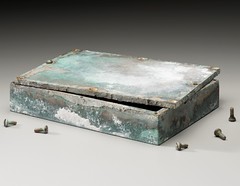 BOSTON, MA (March 11, 2015)—Beginning today, the Museum of Fine Arts, Boston
(MFA), is displaying the contents of the Massachusetts State House time capsule. Originally placed under the State House cornerstone by
Governor Samuel Adams, patriot Paul Revere and Colonel William Scollay in 1795, the time capsule (which was unearthed this past December
and opened in January) is on view to the public from March 11–April 22, 2015, at the MFA, before being reburied in June.
BOSTON, MA (March 11, 2015)—Beginning today, the Museum of Fine Arts, Boston
(MFA), is displaying the contents of the Massachusetts State House time capsule. Originally placed under the State House cornerstone by
Governor Samuel Adams, patriot Paul Revere and Colonel William Scollay in 1795, the time capsule (which was unearthed this past December
and opened in January) is on view to the public from March 11–April 22, 2015, at the MFA, before being reburied in June.
Inside the Box: Massachusetts State House Time Capsule Revealed features 35 objects, including coins, a medal depicting George Washington and a silver plaque believed to be engraved by Paul Revere, as well as the brass box which contained the objects. The exhibition takes place in the Art of the Americas Wing in the Museum’s Kristin and Roger Servison Gallery dedicated to Art of The New Nation (1800-1830). Previously unearthed in 1855, when its contents were documented, cleaned and additional objects were added, the capsule was rediscovered in December 2014. It was then brought to the MFA to be opened and conserved.
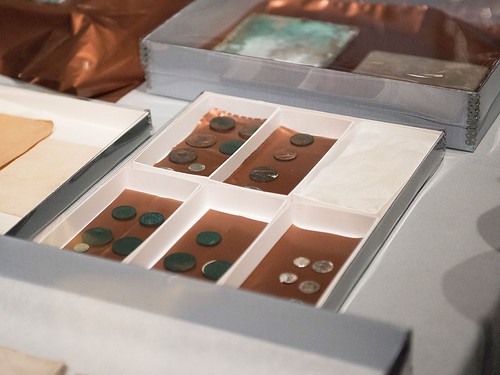
“This MFA exhibition of the State House time capsule contents is a once-in-a-lifetime opportunity for Massachusetts citizens to witness what Revolutionary heroes Samuel Adams and Paul Revere thought significant to preserve when they placed this box in the State House cornerstone just 20 years after the Declaration of Independence. I urge people to visit the Museum to see this significant fragment of Massachusetts history,” said Secretary of the Commonwealth William Galvin.
The installation at the MFA explores the significance of the objects found in the capsule and the role of the prominent figures involved in both the original burial in 1795, and reburial in 1855. Surrounded by related works of art on view throughout the Art of the Americas Wing, visitors will also see iconic portraits of Samuel Adams (about 1772) and Paul Revere (1768) by John Singleton Copley, the Sons of Liberty Bowl (1768) made by silversmith Paul Revere, coins identical to those in the time capsule, and other historical objects in nearby galleries.
For information about the exhibition, see:
Inside the Box
Massachusetts State House Time Capsule Revealed (www.mfa.org/exhibitions/inside-the-box-massachusetts-state-house-time-capsule)
To read the complete press release, see:
Massachusetts State House Time Capsule and Contents
On View for One Month Only at MFA Boston (www.mfa.org/news/inside-the-box-massachusetts-state-house-time-capsule)
THE BOOK BAZARRE
ARTHUR A. HOUGHTON WINS 2015 ANS HUNTINGTON AWARD
The Trustees of the American Numismatic Society have voted to award Arthur A. Houghton, III the 2015 Archer M. Huntington Award in recognition of his outstanding career contributions to numismatic scholarship. The award ceremony will be held on Saturday, May 16, 2015 at 3:00 at the American Numismatic Society, 75 Varick Street, Floor 11, in New York City. The event will include remarks by Mr. Houghton for the Silvia Mani Hurter Memorial Lecture, entitled “Seleucid Excursions: More Questions than Answers,” followed by a reception in his honor.
Mr. Houghton, ANS Honorary Life Fellow and Trustee who served as the President of the Board of Trustees from 1994 to 1999, has been a student of Hellenistic coinages, and particularly those of the Seleucid Empire, for more than fifty years. In that time he has sought to develop his own understanding of the coinages of the Seleucid successors of Alexander the Great, while actively encouraging the detailed study of their coinage by others. He has authored or co-authored numerous articles and several books, most notably, Coins of the Seleucid Empire (New York, 1983); SNG Israel I: The Arnold Spaer Collection of Seleucid Coins (Jerusalem/London, 1988); with Catharine Lorber, Seleucid Coins, Part I: Seleucus I through Antiochus III (New York/Lancaster, 2002); and with Catharine Lorber and Oliver Hoover, Seleucid Coins, Part II: Seleucus IV through Antiochus XIII (New York/Lancaster, 2008).
The Chairman of the Society’s Huntington Committee, Professor Jere L. Bacharach, described the honoree with the following words: “Arthur Houghton’s impeccable background – from his academic credentials to his service with the U.S. government in international affairs, to his fierce determination in following his personal interests – made him an obvious choice for this prestigious award. He pursues his goals whole-heartedly. His contributions to numismatics alone are worthy of recognition, and we are all grateful and indebted to him for the additions to and improvements of our knowledge in this arena.”
Mr. Houghton was born in New York City in 1940. He attended Harvard College, graduating in 1963 with a degree in Government; following a year of travel in the Middle East and Africa, he attained an M.A. degree in Middle Eastern Studies from the American University in Beirut and entered the U.S. Department of State as a Foreign Service Officer. From 1966-1979, he held assignments in Beirut, Amman, Cairo and Washington, D.C., and served on the National Security Council staff from 1974 to 1976.
Mr. Houghton returned to Harvard, attaining a second M.A. degree in Art History in 1981, and was then employed by the J. Paul Getty Museum, Malibu, CA, where he served as Associate Curator and Curator in Charge of Antiquities from 1982 to 1986. From 1988-1995 he was a senior staff member at the White House Office of National Drug Control Policy; and from 1995-2005, was president of Arthur Houghton Associates, Inc., a Washington, D.C. consulting firm. Mr. Houghton has served on the boards of the American School of Classical Studies at Athens, the Cyprus-American Archaeological Research Institute, the Corning Museum of Glass, the Baltimore Museum of Art, the American Numismatic Society, the Middle East Institute and American Near East Refugee Aid (ANERA), among others. From 2011-2013, he was president of the Cultural Policy Research Institute. His public service has included membership in the U.S. Cultural Property Advisory Committee from 1984-1987, and the U.S. Mint’s Citizens’ Coin Advisory Committee from 2007-2011.
For more information on the American Numismatic Society, see:
http://numismatics.org/
NOTES FROM E-SYLUM READERS: MARCH 22, 2015
Josiah K. Lilly Jr. (1893-1966)
Harry Waterson writes:
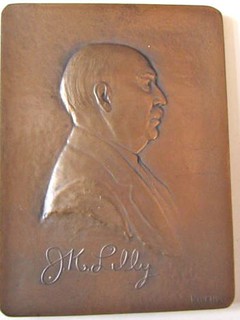 In the March 1 issue of The E-Sylum, Alan V. Weinberg ID’d a J. K. Lilly plaquette as the bas-relief
bust of major numismatist. But there are a number of gentlemen spread over five generations who bear that name; all descendants of Eli
Lilly. Will the numismatist please stand up?
In the March 1 issue of The E-Sylum, Alan V. Weinberg ID’d a J. K. Lilly plaquette as the bas-relief
bust of major numismatist. But there are a number of gentlemen spread over five generations who bear that name; all descendants of Eli
Lilly. Will the numismatist please stand up?
Josiah K Lilly Sr. (1861-1948) Depicted on the plaquette
Josiah K. Lilly Jr. (1893-1966) The numismatist
Josiah K. Lilly III (1916-1995)
Josiah K. Lilly IV DOB 1950
Josiah K. Lilly V
Mr. Weinberg was just a generation too early. Not often that happens.
To read the earlier E-Sylum article, see:
J.K. Lilly Medal (www.coinbooks.org/esylum_v18n09a12.html)
CoinWeek Highlights Mental Hospital Tokens

CoinWeek does a great job choosing and highlighting one E-Sylum article to republish each week. The new images they create are great. This time they went "crazy" and chose the article on Mental Hospital Tokens. Editor Hubert Walker added this comment about the unusual shape of the Brainerd State Hospital token. He writes:
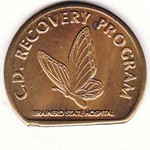 I wonder if it’s not meant to symbolize the sun rising over a landscape, representing
hope? Or maybe the odd shape has something to do with the token’s message of accepting that which we cannot change? You know how
“obsessive” collectors can be…
I wonder if it’s not meant to symbolize the sun rising over a landscape, representing
hope? Or maybe the odd shape has something to do with the token’s message of accepting that which we cannot change? You know how
“obsessive” collectors can be…
To read the complete CoinWeek article, see:
Excerpts from the
E-Sylum: More Mental Hospital Tokens – March 15, 2015
(www.coinweek.com/coin-clubs/excerpts-from-the-e-sylum-more-mental-hospital-tokens-march-15-2015/)
To read the earlier E-Sylum article, see:
MORE MENTAL HOSPITAL TOKENS (www.coinbooks.org/esylum_v18n11a17.html)
April 14
Last week I asked about the numismatic significance of the date April 14, which happens to be the closing date of Fred Lake's next
numismatic literature sale. Paul Cunningham writes:
 April 14? The incorrect date of death of Lincoln found on a fair number of Lincoln tokens and
medals, especially those of Charles Calverley! All of Calverley's medals and plaques, except for one, have the incorrect date. There
is a surprising number of other medals, tokens and plaques which have the same error! We need to redefine "assassination"
perhaps?
April 14? The incorrect date of death of Lincoln found on a fair number of Lincoln tokens and
medals, especially those of Charles Calverley! All of Calverley's medals and plaques, except for one, have the incorrect date. There
is a surprising number of other medals, tokens and plaques which have the same error! We need to redefine "assassination"
perhaps?
Paul adds:
By the way, that date in 43 B.C. the Battle of Forum Gallorun occurred, also, in 1018 A.D. German Emperor Conrad II the Sailor crowned his son Henry III king and in 1828 Noah Webster copyrighted the first American dictionary and, finally, not counting your daughter's birthday, the Detroit Red Wings set an NHL league record 62 games in 1996.
To read the earlier E-Sylum article, see:
LAKE BOOKS SALE #121 CLOSES APRIL 14, 2015
(www.coinbooks.org/esylum_v18n11a02.html)
Joseph Segel and the Franklin Mint
Regarding the TAMS literary award medal provided by the Franklin Mint, Dave Bowers writes:
Interesting about the Franklin Mint. From the mid-1960s when they were the General Numismatics Corporation to 1978, when a feature on CBS “60 Minutes” brought the company crashing to the ground, the Franklin Mint, under marketing genius Joseph Segel (who later founded QVC), was a dominant influence in the rare coin market. In one year the FM was the best performing stock on the NYSE. The numismatic history of the FM and the incredible business success of Joe Segel in multiple endeavors would make a great book.
To read the earlier E-Sylum article, see:
WAYNE’S NUMISMATIC DIARY: MARCH 15, 2015 : TAMS Franklin Mint Literary Award
Medals (www.coinbooks.org/esylum_v18n11a25.html)
Fourteen Bits
Last week I asked how the title of David Ganz's book Fourteen Bits represents the 1976 bicentennial coinage. First to respond
was Tom DeLorey. Here's what I thought was one of the best answers, from Paul Horner, who writes:
How exactly does "Fourteen bits" represent the 1976 bicentennial coinage?
Bicentennial Dollar = 8 bits
Bicentennial half = 4 bits
Bicentennial quarter = 2 bits
Total = 14 bits
To read the earlier E-Sylum article, see:
AMERICAN COINS CHOPPED TO BITS FOR CHANGE
(www.coinbooks.org/esylum_v18n11a09.html)
Harry Manville and the Katen Book Auction Regulars
Dave Hirt writes:
I want to comment on the news of the death of Harry Manville, I remember him as being a regular attendee at the Frank Katen auctions. Although I did not have long conversations with him, as our collecting interests were completely different, he seemed to be a fine English gentleman. He must have been bidding for others beside himself, as he always had at least three different bidder numbers. A library of over TWO TONS, Wow, that's a LOT!
Thinking of the Katen auctions, there was a group of about 8-10 who usually attended. Now the group still with us is shrinking. First Ken Lowe, then more recently Gordon Frost, John Huffman, and now Harry. It makes me feel like a survivor.
To read the earlier E-Sylum articles, see:
LAURESE KATEN 1917-2014 (www.coinbooks.org/esylum_v18n11a06.html)
MORE ON HARRINGTON MANVILLE (www.coinbooks.org/esylum_v18n11a07.html)
Banca Transylvania, Bucharest, Romania
In an e-postcard from Numismatourist Howard Berlin in Bucharest, Romania, he writes:
After clearing customs I see this counter and ATM of the Bank of Transylvania. Considering that Transylvania is Dracula’s neighborhood, I am wondering if this is also a blood bank?
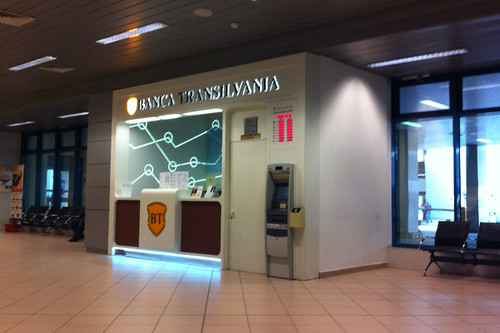
Pre-1960 Nickels
Jeff Starck writes:
It is rather fortuitous that you mention Wayne Herndon is buying 5-cent coins for six cents.
When I was a cashier at Walgreens in high school and college (1997 to 2003), I bought every pre-1960 5-cent coin that came through the drawers. It is a practice I have retained even today, though the volume is minimal compared to the amount that I had access to back then.
Just this weekend I was sorting through a pile of my coins and came across these, some $60 face value or so, and was wondering whether to keep them or cash them in. There would have to be a LOT MORE of them to cover the shipping cost with the 20 percent (but nominal) profit per coin.
To read the earlier E-Sylum article, see:
WAYNE’S NUMISMATIC DIARY: MARCH 15, 2015
(www.coinbooks.org/esylum_v18n11a25.html)
Surveyors of the King's Private Roads
Yosef Sa'ar of Elat on the Red Sea writes:
Several examples of the King's Private Roads metal passes have been posted recently with images in the Facebook group Transportation Token Collectors. One of the queries entered was the highest known counterstamped serial number. So far the Rich Hartzog 1624 takes honours.
The 'TR' initials between the 17 and 37 stand for Thomas Ripley, surveyor of the King's Private Roads from 1737.
The 1731 example carries 'RA' for Richard Arundell, Surveyor of the King's Private Roads, 1731-37.
I invite E-Sylum readers to the Transportation Token Collectors Facebook group, open to all.
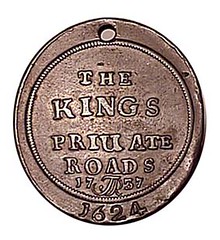

To read the earlier E-Sylum articles, see:
ADMISSION TICKETS & PASSES (www.coinbooks.org/esylum_v18n10a22.html)
NOTES FROM E-SYLUM READERS: MARCH 15, 2015 : The Kings Private Roads Token
(www.coinbooks.org/esylum_v18n11a10.html)
Numismatology and Numismatic Paperweights
George Kolbe writes:
Over the past four decades, I have acquired a half dozen numismatic paperweights, loosely so-called. Acquired from several different countries, they adorn my worktable and are often useful. One of my favorites came to mind as I read about “Numismatology and William Sunday” in last week’s E-sylum. It is the original obverse die used to strike the medal depicted in the article; and nestled in it is a specimen of said medal.
Some years ago, Frank Van Zandt happened to mention that several Rochester Numismatic Association dies were coming up for sale at a club meeting and I asked him to buy one for me. Soon thereafter, a heavy die arrived in the mail and, later, Frank managed to get me one of the medals struck from it. The pair weigh in at over 4.5 pounds, really too heavy for their stated purpose. It is used mainly when I am pasting a bookplate into new acquisitions in my numismatic reference library. It also serves to eloquently explain to neophytes, with nary a word being spoken, how coins and medals are made.
Scott Miller writes:
Regarding the William Sunday bookplate, I have never seen it before. However, I do have a bound volume of Numismatology, a British publication edited by T. Forster in Colchester beginning in 1892. The book contains 3 years of issues, which I believe was the entire run.
To read the earlier E-Sylum article, see:
NUMISMATOLOGY AND WILLIAM SUNDAY (www.coinbooks.org/esylum_v18n11a12.html)
DR. HENDERSON AND WILLIAM ASHBROOK
Another nice group of articles in the latest Asylum, Volume 32, Number 4. Of particular interest to me was David Fanning's "Off the Shelf" article about "The Sales of J.M. Henderson".
I was introduced to Henderson upon reading the diaries of William Ashbrook, the Congressman from Ohio who was instrumental in securing the ANA's Federal Charter.
Both were members of the Ohio State Numismatic Society as early as 1907, from what I can glean from the diaries, and became fast numismatic friends.
Saturday, August 8, 1908
Ran over to Columbus this afternoon to see Dr. Henderson about an auction of old coins.
Saturday, Sunday, November 28-29, 1908
Dr. Henderson came home with me... we looked at my coins tonight. He is a coin crank, but a mighty good fellow. Spent the entire day
(Sunday) with Dr Henderson and my coins. I am figuring on having a coin sale to sell my duplicates.
I was surprised that Henderson hadn't organized an auction before 1932, as shown in David's article. Clearly, there was some interest there much earlier, as he repeatedly mentored Ashbrook in regard to buying and selling coins.
Thursday, June 3, 1909
We (Henderson and Ashbrook) came to attend a coin sale by Henry Chapman. My first coin sale. Took dinner with Zerbe, president of ANA.
Dr. Henderson is a candidate to succeed Zerbe.
Friday, June 4, 1909
Henderson took me to all of the curio shops in the city. (Philadelphia) Attended the coin sale from 1 to 6 pm. Hudson Chapman invited us
for dinner. He has a wonderful collection of Greek coins.
Saturday, Sunday, September 25-26, 1909
Dr. Henderson and his wife came over on the evening train and we worked on my coins until midnight. (Sunday) The Doctor spent most of the
day with me, shaping up my coins for the auction.
Thursday, Friday, October 28-29, 1909
Went to Columbus this morning to attend the meeting of the Ohio State Numismatic Association. (Friday) We had our great coin sale
today...we sold 745 lots...two thirds of the coins sold were mine, and I am rid of most of my duplicates and at a very nice profit.
Monday, November 6, 1911
Received word today that I had been elected on the Board of Governors of the ANA and Henderson was re-elected its President.
Wednesday, November 29, 1911
Dr. Henderson had lunch with me at the Neil House.
This entry is interesting, as according to Fanning's article, the Neil House was the site of Henderson's first auction some twenty years later. That auction was in conjunction with the Ohio State Numismatic Society, as were several of his other auctions. It seems that in the twenty years between the time Henderson was ANA president and his first auction with the OSNS, that he might have had some connection, albeit undocumented, with the yearly Ohio auctions.
There are nearly two dozen references to Henderson in Ashbrooks diaries between the years 1907 and 1916. Ashbrook's interest in coins deteriorated after that, but Henderson's zeal for numismatics continued.
Great article, David. Thanks!
For more information on the Numismatic Bibliomania Society, see:
www.coinbooks.org

NEW MEDAL DISPLAY AT PHILADELPHIA MUSEUM OF ART
Jack Hinton, Associate Curator of European Decorative Arts & Sculpture, announced the opening of a new gallery at the Philadelphia Museum of Art in Philadelphia, Pennsylvania. Titled ART AND WONDER: A CABINET OF COLLECTIONS, the gallery displays a collection of extraordinary objects and works of art from the 16th to early 18th centuries. Among the highlights of the exhibit are a group of portrait medals from the collection of Ben Weiss. The collection includes 17th century medals by Muller, Dadler, Soldani-Benzi, Vismara, Hamerani, van Abeele, and Dupre.
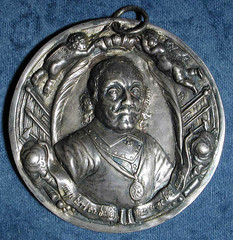

"Death of Admiral Maarten Harpertzoon Tromp at the Battle of Texel" by O. Muller
PHILADELPHIA MUSEUM OF ART
Art and Wonder: A Cabinet of Collections
January 22, 2015 – ongoing (Gallery 257, Main Building, 2nd Floor)
The desire to collect extraordinary objects and works of art is explored in a new installation at the Museum titled Art and Wonder: A Cabinet of Collections. Featuring around 100 finely wrought and fascinating items, the display examines the formation of encyclopedic collections in Europe between the 1500s and early 1700s, often described at the time as cabinets of curiosities or a “Kunstkammer” (art room in German.)
The ideal Kunstkammer contained works of nature and human invention in exceptional and varied forms, to create a microcosm of the known universe. This interest reflects the perception-changing discoveries in geography, astronomy and science that took place in the period. With objects ranging from paintings and sculptures to tools, keys, game boards and shells, the installation explores the phenomenon of collectors cabinets and the varied categories of works gathered within them.
Highlights include a painting by Jan Brueghel the younger (acc. cat. 656) depicting an imaginary collection of the time, a princely chiseled steel powder flask given to Augustus the First, Prince Elector of Saxony and founder of his own courtly Kunstkammer (acc. 1991-9-3,) and a rare ebony and ivory game board from the workshop of Ulrich Baumgartner, master curiosity-cabinet maker of Augsburg (acc. 1964-91-17.) A significant group of portrait medals lent by collector Benjamin Weiss, including Muller’s silver Medal of Admiral Maarten Tromp, Dadler’s Medal of The Battle of Breitenfeld and one of Soldani-Benzi’s medals of Queen Christina of Sweden, reveal the importance of these objects for collectors to demonstrate their connections to and interests in historical and present-day individuals and events.
For more information about the illustrated medal, see: DEATH OF ADMIRAL MAARTEN
HARPERTZOON TROMP (www.historicalartmedals.com/MEDAL%20WEB%20ENTRIES
/THE%20NETHERLANDS/MULLER-TROMP-BW333%20HIGH.htm)
To read the complete article, see:
Art and
Wonder: A Cabinet of Collections (www.medalcollectors.org/News/Art%20
and%20Wonder%20-%20gallery%20257%201%20page%20desc%20for
%20Ben%20W%20(3).pdf)
ISAAC NEWTON DESIGNED QUEEN ANNE'S CORONATION MEDAL
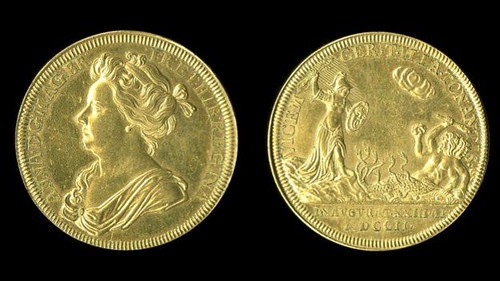
A student at Oxford University has discovered that a coronation medal was personally designed by Isaac Newton and includes a hidden political message.
Postgraduate student Joseph Hone found a manuscript which revealed the scientist had designed the medal for Queen Anne's coronation in 1702.
It explained the design as symbolising the dual threats of France and rival Stuart claimants to the throne.
Researching in the National Archives in Kew, Mr Hone found Newton's handwritten account of designing the commemorative medal.
The 50-page document had been overlooked for years, he said, as the clasp holding the pages had rusted over.
The design had previously been thought to have been the work of a court painter, but the manuscript shows that Newton, who was Master of the Royal Mint at the time, was responsible.
Newton's notes reveal that the depiction of the queen as a Greek goddess striking down a monster was not a random picture of a national defender, but a specific reference to contemporary political threats to her rule.
In the iconography of this 18th Century propaganda, the creature with two heads represents the joint threat of the French king, Louis XIV, and the so-called "Old Pretender", James Stuart.
Queen Anne was the daughter of the deposed Catholic monarch, James II, and the old king's son, James Stuart, was living in exile and claiming that he had a more legitimate right to the throne.
The medal shows Queen Anne facing this threat of a Catholic alliance between France and the exiled Stuarts, headed by her half-brother James.
Gold versions of the medal were to be given out to "persons of quality", according to the notes, with cheaper silver versions to be thrown to the crowds.
To read the complete article, see:
Isaac Newton royal medal design discovery
(http://m.bbc.com/news/education-31965063)
LORD ASHCROFT MOVES TO KEEP MUNRO MEDALS IN NEW ZEALAND
Lord Ashcroft KCMG PC has at the eleventh hour stepped in with a proposal to keep the Munro WWII medals and associated memorabilia within New Zealand while still achieving aviation war hero, Les Munro’s, altruistic aim of providing funds for the upkeep of the Bomber Command Memorial in London. This offer comes only hours after local museums confirmed they had not been able to agree to a solution with Mr Munro and could not participate in the auction of the medals as a consortium.
Lord Ashcroft has offered to donate £75,000.00 to the Royal Air Force Benevolent Fund that looks after the Memorial in London in return for Mr Munro withdrawing the medals from auction and gifting them to the Museum of Transport and Technology (MOTAT) in Auckland. Mr Munro’s awards, which include the Distinguished Service Order and the Distinguished Flying Cross, are expected to fetch between £40,000 and £50,000 if the auction goes ahead.
MOTAT in turn has offered to cover the auctioneers, Dix Noonan Webb’s, reasonable fees and out of pocket expenses on Mr Munro’s behalf.
Lord Ashcroft stated “I believe this proposal is win-win situation whereby Mr Munro secures substantial funds for the upkeep of the Bomber Command Memorial in Green Park, and his medals and associated memorabilia are gifted to the Museum of Transport and Technology in Auckland for the benefit of the Nation”. The details of the proposal were discussed during a visit by Lord Ashcroft to MOTAT yesterday where he undertook a personal tour of one of the last remaining Avro Lancaster Bombers housed in the Museum’s Aviation Display Hall.
Lord Ashcroft was one of the driving forces behind the Bomber Command Memorial which commemorates the contribution and sacrifice of the thousands of young airmen who died while flying with the Bomber Command during World War Two. He donated over £1 million to the initial Memorial appeal as well as the royalties from his book, ‘Heroes of the Skies’ to the Royal Air Force Benevolent Fund.
Lord Ashcroft is the author of eight books, including five on gallantry, which tell of his lifelong interest in valour and reveal the extraordinary stories behind the gallantry medals in his collection.
To read the complete article, see:
Lord Ashcroft’s Proposal to
Keep Munro Medals in NZ (www.scoop.co.nz/stories/CU1503/S00352/lord-ashcrofts-proposal-to-keep-munro-medals-in-nz.htm)

MARY MARTIN'S 'SOUND OF MUSIC' TONY AWARD MEDAL
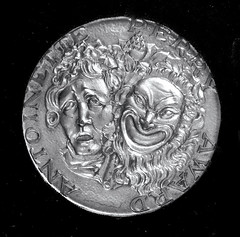
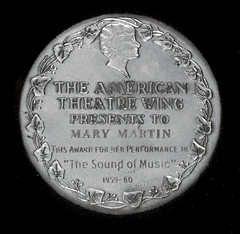
Exceedingly desirable American Theater Wing Antoinette Perry Award, commonly known as the ‘Tony,’ measuring 2.75″ in diameter, engraved on the reverse: “The American Theatre Wing Presents to Mary Martin This Award for her Performance in ‘The Sound of Music,’ 1959–60.” The front of the medal features the traditional symbolic dramatic masks raised in relief, encircled with the text, “Antoinette Perry Award.” Presented in a soft cloth-lined display, believed to be original to Martin, to an overall size of 6 x 6. In fine condition, with some light tarnishing.
 Originally acquired from the estate of Martin’s son, actor Larry Hagman. Martin was one of
Rodgers and Hammerstein’s darling actresses and cast as Maria von Trapp in The Sound of Music in the original Broadway production of the
iconic musical, which opened on November 16, 1959. All together, the show took home six Tony Awards in 1960, including Best Musical. This
award represents Martin’s third and final Tony win. An iconic piece honoring one of the most famous musicals of all-time.
Originally acquired from the estate of Martin’s son, actor Larry Hagman. Martin was one of
Rodgers and Hammerstein’s darling actresses and cast as Maria von Trapp in The Sound of Music in the original Broadway production of the
iconic musical, which opened on November 16, 1959. All together, the show took home six Tony Awards in 1960, including Best Musical. This
award represents Martin’s third and final Tony win. An iconic piece honoring one of the most famous musicals of all-time.
To read the complete lot description, see:
#3177 - Mary Martin’s 1960 Tony Award for The Sound of Music
(www.rrauction.com/bidtracker_detail.cfm?IN=3177)
ROYAL MINT UNVEILS NEW 2017 POUND COIN DESIGN
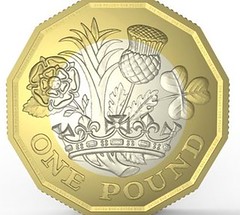 The new £1 coin will feature a drawing by a 15-year-old who has won a competition to design the
"tails" side.
The new £1 coin will feature a drawing by a 15-year-old who has won a competition to design the
"tails" side.
David Pearce, from Walsall, was told the news by Chancellor George Osborne, who said the image would be "recognised by millions in the years ahead".
It features the four plants associated with the four nations that make up the UK.
The new coin has the same shape as the old 12-sided threepence piece (3d) - not used since 1971.
"I was really excited to hear that I had won the competition to design the new £1 coin but hugely shocked as well," said David.
"I heard about the competition through my design teacher at school and I thought I had nothing to lose so I decided to enter.
"I spent a lot of time researching what coin designs looked like and what sort of designs would represent all parts of the UK before submitting my idea and I honestly cannot believe I have won."
His design features the leek, thistle, shamrock and rose, coming out of a royal coronet, or crown.
The Chancellor rang the teenager to tell him the news.
"Designing the new £1 coin was a brilliant opportunity to leave a lasting legacy on what will be the most secure coin in circulation anywhere," he said
David beat competition from more than 6,000 entries and will see his design in circulation in 2017.
The £1 is being replaced for the first time in more than 30 years because of fears it is now easier to counterfeit.
To read the complete article, see:
New £1 coin design, created by a teenager, revealed by Mint
(www.bbc.co.uk/newsbeat/31938400)
It was fifteen-year-old David Pearce’s floral concept that was selected as the favourite from some 6,000 entries. The final design features four emblems to represent each of the nations of the United Kingdom – the rose for England, the leek for Wales, the thistle for Scotland, and the shamrock for Northern Ireland – emerging from a single stem within a crown. These emblems have long been used to represent each of the nations, and have featured on UK coins as recently as 2013/14 on four floral £1 coin designs.
David Pearce’s design has been refined for use on the final coin with the support of the renowned numismatic artist David Lawrence – who designed the 2015 200th Anniversary of the Battle of Waterloo UK £5 coin – and lettering expert Stephen Raw – who also advised Jody Clark on the lettering for his fifth Royal portrait design.
To read the complete article, see:
The new £1 coin winning design revealed
(http://blog.royalmint.com/new-one-pound-coin-winning-design-revealed/)
ARTICLE TIES ANNE BINGHAM TO U.S. COINAGE
As the new government moved to create a new federal identity on its money, the images that would appear on those coins became an item of great decision.
 They
wanted a graceful, beautiful image of a classic figure upon the coins. President George Washington turned to the most prominent portraitist
of the day, Gilbert Stuart. He showed Washington a drawing of 31-year-old Anne Willing Bingham. Anne was the wife of William Bingham, on
whose land all of Binghamton and the surrounding area now stands. The Binghams were prominent members of society, with social connections
to the Washingtons, Jeffersons and Madisons. Anne's father, husband and father-in-law were all bankers in Philadelphia.
They
wanted a graceful, beautiful image of a classic figure upon the coins. President George Washington turned to the most prominent portraitist
of the day, Gilbert Stuart. He showed Washington a drawing of 31-year-old Anne Willing Bingham. Anne was the wife of William Bingham, on
whose land all of Binghamton and the surrounding area now stands. The Binghams were prominent members of society, with social connections
to the Washingtons, Jeffersons and Madisons. Anne's father, husband and father-in-law were all bankers in Philadelphia.
The Binghams were known throughout the new states, and Anne's beauty was acknowledged by many. Anne was also acknowledged for her promotion of the arts and had commissioned Stuart to paint several portraits of Washington, including the model for the image that still adorns the dollar bill.
Washington readily agreed that she would be the model for the newly designed coins of the United States. John Eckstein was paid $30 for plaster models of Anne's image that would be used by Mint Chief Engraver Robert Scott to create the dies used for the coins. The image of Anne Bingham became known as the Draped Bust Liberty. Although Stuart expressed his displeasure at how the image based on his drawing was used, the coins quickly became popular.
The coins were introduced in the fall of 1795, and her image appeared on every non-gold coin until the design was changed in 1808. But by then, more than 23 million of those coins had been introduced into the American society. This was at a time when the entire population of the country stood at 5.3 million. It was likely that at one time or another in the first two decades of our history, everyone had a coin with Anne Bingham's likeness with them.
To read the complete article, see:
Early coins
featured famous Binghamton face
(www.pressconnects.com/story/news/connections/history/2015/03/18/spanning-time-anne-bingham-coin/24968691/)
To read an earlier E-Sylum article, see:
QUERY: WAS GILBERT STUART SKETCH THE MODEL FOR DRAPED BUST COINAGE?
(www.coinbooks.org/esylum_v13n13a15.html)
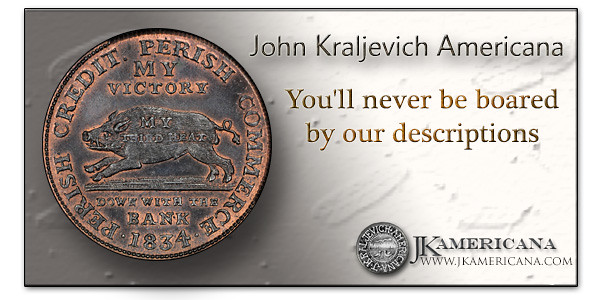
SELECTIONS FROM DAVE WNUCK'S MARCH 2015 INVENTORY
1852 Braided Hair Proof Half Cent
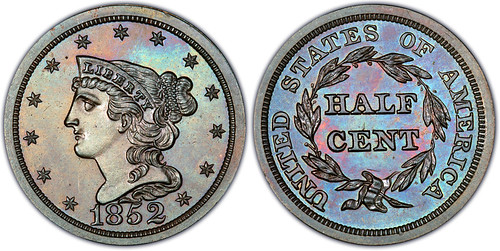
1821 Guatemala One Real
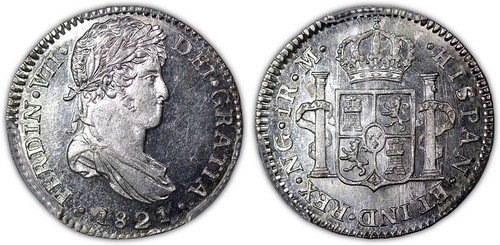
A stunning, flashy coin that looks like it was minted 2 years ago and not 2 centuries ago. Untoned, with fully prooflike fields on both sides.
1806 Agricultural Medal
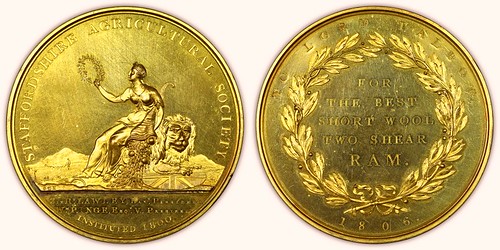
A large, impressive medal that looks and feels like solid gold, but was expertly gilt when made. Includes custom made copper shells that have been silver plated on their interiors.
The obverse reads: Staffordshire Agricultural Society; the engraving under the exergue says: Sir Rt. Lawley Bart. President/Wm Pinge, Esqr. V. President/ Instituted 1800. The reverse reads: To Lord Talbot/For the Best/Short Wool/Two Shear/Ram/1806. Edge: Plain. Diameter = 48 mm (= 1 3/4 inches).
Alert. This is a Special Coin Dealer Honesty Announcement: I bought this medal simply to put into my display case at the Portland ANA coin show, so I would have something big, gold, proof-like, flashy and unique to put in my display case. The goal? To literally stop people in their tracks. Did it do the job? Yes; yes it did. If it doesn't sell, no biggie, as it comes in handy at coin shows.
To read the complete newsletter article, see:
http://us10.campaign-archive2.com/?u=648e8b4522a9e91a13d18de6a&id=f1c2f7020b&e=c715309517
A GOBRECHT DOLLAR RETURNS HOME
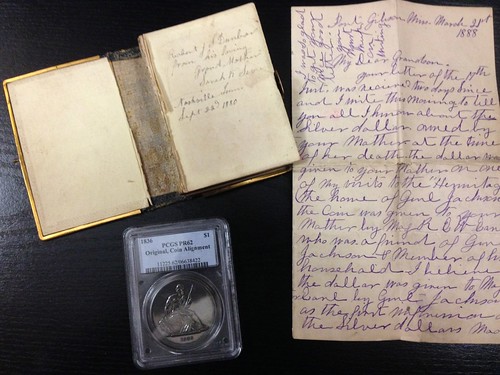
In August 2010, a Carlisle, PA resident discovered an 1836 Gobrecht dollar in her mother’s safety deposit box. The coin was unknown to anyone in the family, and the mother, a victim of Alzheimer’s, was unable to provide further information. The daughter and her husband researched the coin and placed it with the Hershey, PA dealer Rich Uhrich for sale. Uhrich advised having the coin certified, and the newly-slabbed PCGS PR62 coin was sold in October 2010 with the proceeds allocated to the aged mother’s nursing care.
That was seemingly the end of the story but no one could explain why a 91 year-old woman was in possession of a Gobrecht dollar. The fairer sex are not generally known as numismatists, and, even more, this was no mere accumulation of pocket change. This was a scarce, five-figure coin, a coin that marked the Mint’s transition from Bust to Liberty Seated coinage. All that could be said at this point was that the family had successfully concluded a fair deal and put the money to good use.
Fast forward to September 2011. The daughter continued to work through her mother’s affairs and completely cleaned out the safety deposit box. An old bible, inscribed by the daughter’s great-great-grandmother, hid a long-forgotten letter, and this is the beginning of our story. The great-great-grandmother, Sarah Knox Sevier (1812-1891), had left a message to future generations. An old Chinese proverb states that the palest ink is better than the best memory, and Sarah K. Sevier’s written account of this Gobrecht dollar is a reminder that it is not hard for documentation to outlast recollection.
Port Gibson, Mississippi. March 21, 1888.
My Dear Grandson,
Your letter of the 17th was received two days since and I write this morning to tell you all I know about the silver dollar owned by your
mother at the time of her death. The dollar was given to your mother on one of my visits to the Hermitage, the home of General Jackson. The
coin was given to your mother by Major R. E. W. Earl who was a friend of General Jackson and member of his household. I believe the dollar
was given to Major Earl by General Jackson as the first impression of the silver dollars made or coined when General Andrew Jackson was
president.
I have understood there were only a few made perhaps only one dozen, indeed I have been told the Coin Book says there were only six made but I never saw a coin book and I don’t know but whether there were few or many made. The dollar you have is one of the number and was given to your mother in 1837 when she was an infant, by Major Earl, who was a beloved member of General Jackson’s family and my dear uncle by marriage. He was a celebrated artist.
The coin was given to your mother, my darling first born child, at The Hermitage. It was put in her hands by Major Earl & I have one given to me by Mrs. Jackson, wife of General Jackson’s adopted son. I gave mine to your Aunt Eliza. Your mother told me she had been offered $100 for her dollar but friends advised her not to take that. They said the coin would be worth $1000 in a few years. I wish you or Nannie Bell could keep it as a precious “heirloom” but know there are debts owing which ought to be paid, especially the debt to the undertaker in Ashville and the doctor’s bill. These are sacred debts, dear Robbie, and ought to be paid if possible. I hope Mr. Kanning will help you pay them. I suppose Nannie Bell got most of her mother’s furniture too.
If ever you can spare the time and money to come and see us dear Rob, you will be welcomed warmly by us all. You can send this letter to Mr. Christian as it may help him to sell your dollar…Write me when you can and tell me what the prospects are for disposing of the dollar. May God bless and take care of you my dear grandson always.
Your Loving Grandmother,
Sarah K. Sevier
The discovery of this letter resolved one mystery – it explained why the Gobrecht dollar had been carefully preserved in the bank box. But now there was a second mystery – the coin had been sold, and its whereabouts were unknown. Uhrich checked with his buyer, a high-volume dealer who had quickly flipped the coin after acquiring it. There was no contact information for the next owner in line, and so the trail went cold. The original seller made inquiries with a number of industry insiders, including Jim Halperin and Dave Bowers. Both dealers were responsive and helpful, but still, a connection could not be made. In the meantime, Uhrich connected the present writer with the original seller, who furnished the documentation, including a scan of the coin and the 1888 letter. The author now had the provenance, but where was the coin?
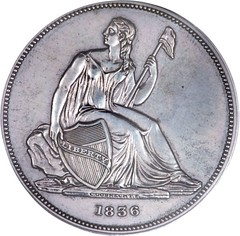

Three years later, at the Whitman fall Baltimore show, the author walked past dealer Kevin Lipton’s table and spied something that looked familiar – an 1836 Gobrecht dollar, graded PR62 by PCGS. Could it possibly be the same coin? I walked to a nearby, empty table (it was a Saturday, and a number of dealers had packed up) and pulled out my cell phone. I dialed up the Heritage Auction Archives website, just to be doubly sure. There was no mistaking it, the PCGS certification number matched, and the marks on the coin were the same. There was a spot at Liberty’s right (facing) knee, a tiny pit in the left obverse field, and a minor rim defect at the top of the reverse.
I quickly walked back to Lipton’s table. He was packing up himself, so I asked the price on the Gobrecht dollar and told him I would give him a call on Monday. Over the weekend, I contacted the original seller – was she still interested in the coin? If she wasn’t, I was most interested in purchasing the documentation. She still wanted the coin, and I was pleased to see it go back into the family. I brokered the deal, and it was in her hands within a few days. She has explained the situation clearly to her own children, and it is certain they will not find a forgotten Gobrecht dollar in her safety deposit box!
For more information on the Liberty Seated Collectors Club, see:
www.lsccweb.org
HENRY P. KENDALL FOUNDATION COLLECTION PREVIEW
On March 26 Stack’s-Bowers, in conjunction with the Whitman Baltimore Expo, will be offering a collection of primarily early American coins and currency, sold under the name of and on behalf of the Henry P. Kendall Foundation. Assembled over more than 50 years by a dedicated collector, the sale will represent the 2nd large collection of early American coins to come to the market this year, the first being the Partrick collection sold in January by Heritage. In this article we will take a look at the Kendall Foundation auction, which is comprised of 557 widely varied lots, ranging from Federal coins to medals, tokens, world coins and contemporary counterfeits. A PDF copy of the catalog can be accessed online by clicking the following link: http://media.stacksbowers.com/VirtualCatalogs/2015/Stacks-Bowers-Galleries/Mar2015-Baltimore/SBG_Mar2015_Balt_Kendall_Catalog_LR.pdf
Many collectors, when assembling a specialized collection, will wish to acquire the finest grades they can afford. This collection, however, is different, as many common coins are in circulated grades, the personal preference of the collector (who goes unnamed in the catalog, and is only identified as a “collector from the Midwest”) who assembled the collection. This does not mean that some of the coins or currency in the collection are not the finest known; in fact, this is hardly the case, as especially the collection of Massachusetts silver coins is among the finest (if not THE finest) collection of that material ever assembled in one place.
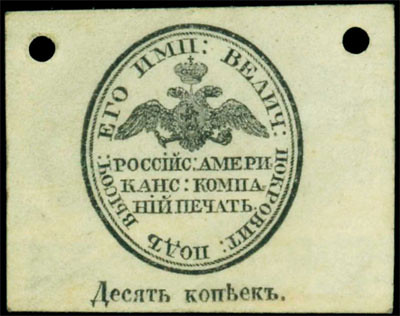
The sale starts with 219 lots of Colonial and Continental currency, including a number of rarities seldom offered for sale. Lot 2001, for example, is a very rare 10 Kopeck note printed for the Russian-American Company, dating back to the mid 19th century, and meant for circulation in the parts of North-America that were claimed by Russia. The lands claimed by Russia stretched from Alaska to as far south as Fort Ross in present-day California, and the company even claimed a presence in Hawaii (Fort Elizabeth). Active in the fur and seal trade, some notes were printed to facilitate this trade, all of which are now very rare. The note offered by Stack’s-Bowers, graded Choice New 63PPQ by PCGS Currency is among the finest known of this historically important issue. Other lots of paper money include rare issues of Massachusetts, New Hampshire and Vermont, as well as rare issues of Continental Currency seldom offered for sale.
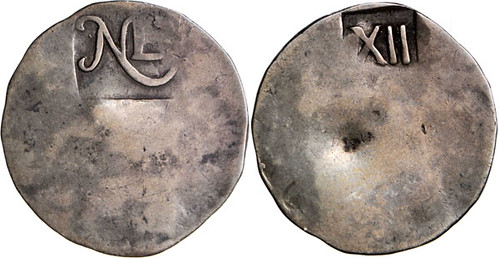
The coin part of the collection starts with lot 2301, one of just eight Noe 1-A NE Shillings in private hands, graded PCGS EF45. The coin is a high-quality example of the earliest coinage struck on the North-American continent in what today is the United States. The next lot, 2302, is an even rarer Noe 1-D variety of the same denomination, graded VF30 by PCGS. This is not the last New England Shilling to be offered, however, as the collection has an amazing number of six(!) examples of this very rare and historic issue. The New England Shillings are complemented with one of just four New England Six Pences in private hands. Offered as lot 2307, the coin is one of just seven examples known to exist in total, and is graded EF40 by PCGS.
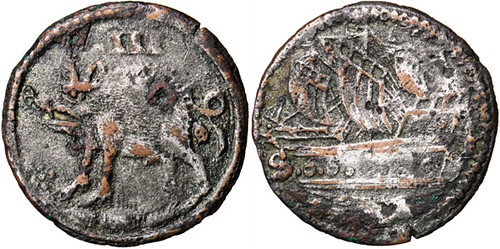
After the extensive offering of Massachusetts silver come even more colonial rarities. Offered are a number of examples of the earliest coinage struck for North-America, the Sommer Islands coinage struck for coinage on what is now known as Bermuda. While not technically part of the series related to the United States, they have been included in the Red Book forever, and are now an important part of American Colonial Numismatics. The highlight of this coinage is perhaps lot 2448, one of just three Sommer Islands Threepences in private hands, graded EF40 by PCGS. Like all Sommer Islands coinage the piece shows less than perfect surfaces, as virtually all have been dug up on the island. The rarity of the coin makes that the quality is less important and the coin should see spirited bidding.
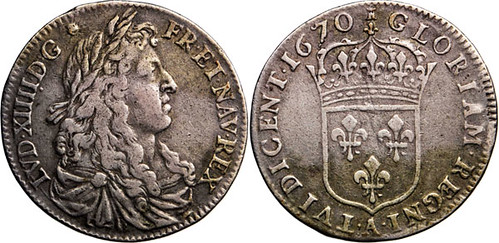
Another colonial rarity that is perhaps not as well known if you are not a specialist of colonial coins is lot 2494. It is a very rare 1670-A 15 Sols struck for the French Colonies in America, one of just six in private hands, with about fourteen pieces known to exist in total. The coin is the largest denomination of a series struck for an area that included much of present-day Canada as well as some parts of the United States, and a major rarity of importance to colonial collectors. The coin is graded VF35 by PCGS and is plated in Walter Breen’s famous Encyclopedia.
To read the complete article, see:
Henry P. Kendall Foundation Collection Preview
(http://news.coinupdate.com/henry-p-kendall-foundation-collection-preview-4740/)
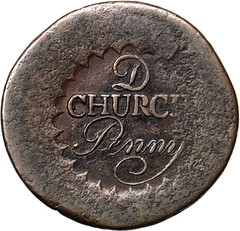

Undated (1790) Albany Church Penny. W-8500. With D Added. EF-40 (PCGS). CAC. 121.3 grains. A beautiful example of the most popular American communion token, struck over a very well worn English halfpenny that was still circulating in the Hudson Valley a century after it was made.
In our (Stack's) Ford II sale of 2004, we offered specimens of both with With D and No D varieties. The With D brought more than the No D, but perhaps not enough more to give this variety its proper premium for rarity. Long assumed to be of about the same rarity, it actually looks like this variety is the rarer of the two by a significant margin. Mike Hodder recorded just five specimens known to him: the Ford coin, boldly overstruck on a George III counterfeit halfpenny; a specimen in the Partrick collection; one in a well known Rhode Island collection, also overstruck on a George III counterfeit halfpenny; the Robison-Roper coin; and the Picker coin.
To read the complete lot description, see: Undated (1790) Albany Church
Penny. W-8500. With D Added. (www.stacksbowers.com/BrowseAuctions/LotDetail/
tabid/227/AuctionID/6065/Lot/2530/Default.aspx)

WILLOW TREE SILVER COINS
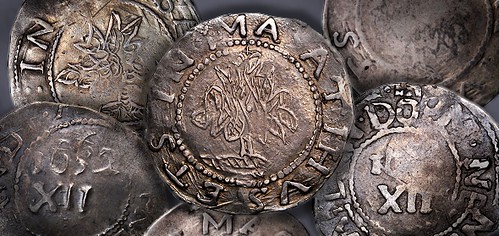
The Kendall Collection, which will be auctioned by Stack’s-Bowers on March 26th in Baltimore, contains a landmark group of Willow Tree coins, as part of one of the all-time greatest, overall collections of Massachusetts Silver coins. The Kendall Collection also features other pre-1793 coins and Civil War era American numismatic items.
Three denominations of coins were authorized and struck in Massachusetts, starting in 1652: twelvepence, sixpence and threepence coins. Twelve pence equaled one shilling and twelvepence silver coins were typically termed shillings.
It may be true that Willow Tree coins were minted from 1653 to 1660; Oak Tree type coins were minted from 1660 to 1667; and Pine Tree type coins were produced from 1667 to 1683. Although some illuminating documents survive, the exact time-line will never be known to researchers now.
In the past, there was debate among researchers as to how Willow Tree coins were minted. It seems clear that a screw press was not used. American colonial coins during the 1700s and U.S. coins from 1793 to the mid 1830s were typically produced with a screw press.
Christopher Salmon, MD, recently authored a landmark reference on Massachusetts Silver coinage. Salmon is a collector and a member of the board of trustees of the American Numismatic Society (ANS). He is also the chairman of the committee that oversees the coin collection of the ANS museum.
Dr. Salmon concludes that Willow Tree coins “were definitely hammered and cold-struck.” The circular blanks were not heated before being struck.
Salmon’s research indicates that “all of the finishing work done by silversmiths of the time period was done cold, including the striking of touch-marks,”
To read the complete article, see:
Willow Tree Silver Coins of Massachusetts: The Second Type of Coins Struck in the Original Thirteen Colonies
(www.coinweek.com/auctions-news/stacks-bowers/willow-tree-silver-coins-of-massachusetts-the-second-type-of-coins-struck-in-the-original-thirteen-colonies/)
MORE ON FOOD STAMP CHANGE TOKENS
I recall that Neil Shafer mentioned some of the literature on the topic of food stamp change. Perhaps some of the following would help Mr. Hopkins in his research.
Food Stamp Change Newsletter – published by Jerry Schimmel, San Francisco, from 1980 to 1984, 17 issues in all. Mailing list was small, a little >50, but included many well-known exonumia collectors and writers.
Food Stamp Change Token Stores by Jerry Schimmel, copyright 1980 – a 101 page nationwide and territorial listing of stores that are known to have issued food stamp tokens.
Iowa Food Stamp Tokens by Lewis K. Ferguson, April 1983 – 23 page well illustrated list published by Food Stamp Change Newsletter.
New York State Food Stamp Change Tokens by Gary Pipher, January 1982 –35 page partially illustrated catalog published by Food Stamp Change Newsletter.
New Jersey Food Stamp Tokens – 3 part catalog. Parts 1 and 2 by Gary Patterson, in Token and Medal Society Journal, December 1979, and supplement to Food Stamp Change Newsletter, October 1980. Part 3 by Al Zaika, manuscript awaiting publication in The Nor-Easter, newsletter of Northeast TAMS.
Food Stamp Tokens – 20 page fixed price list published circa 1980 (undated) by Paul A. Cunningham of Tecumseh, MI., an early advocate of food stamp change token collecting.
Neil Shafer’s article(s) in The Numismatist
“Platco” Plastic Trade Checks – by David Gladfelter, in TAMS Journal, December 1977. This company made food stamp change tokens, among other exonumia products.
Plasco Plastic Specialty Tokens – by David Gladfelter, TAMS Journal, December 1978. The company was a large producer of food stamp change tokens.
These sources should be available from the ANA library and/or the TAMS library.
To read the earlier E-Sylum articles, see:
FOOD STAMP CHANGE TOKEN INFORMATION SOUGHT
(www.coinbooks.org/esylum_v18n04a06.html)
THE HISTORY OF FOOD STAMP CHANGE TOKENS
(www.coinbooks.org/esylum_v18n05a11.html)
FOOD STAMP CHANGE TOKEN RESEARCH UPDATE
(www.coinbooks.org/esylum_v18n06a11.html)
DISCOVERY SHEDS LIGHT ON BOX AND 'OPIUM' DOLLARS
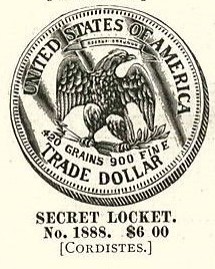 What
have been termed as opium dollars may never have really been used for the purpose of smuggling opium. Sure there are some James Bond style
spy coins in the world of exomunia and include various hidden compartment coins and magician’s coins. The compartment coins include both
single coins and boxes that resemble a stack of coins. Of the single coin style, the Great Britain two pence or “cartwheel” coin has the
largest interior capacity. These are threaded and come apart into two pieces as opposed to the countersunk hinge on the trade dollar box
coins. When closed, both resemble ordinary coins but the extra thick copper two pence allows much more space inside for “smuggling”.
What
have been termed as opium dollars may never have really been used for the purpose of smuggling opium. Sure there are some James Bond style
spy coins in the world of exomunia and include various hidden compartment coins and magician’s coins. The compartment coins include both
single coins and boxes that resemble a stack of coins. Of the single coin style, the Great Britain two pence or “cartwheel” coin has the
largest interior capacity. These are threaded and come apart into two pieces as opposed to the countersunk hinge on the trade dollar box
coins. When closed, both resemble ordinary coins but the extra thick copper two pence allows much more space inside for “smuggling”.
As for opium dollars, that term has been used extensively when referring to the trade dollar hidden compartment coins. Trade dollars were originally made to facilitate trade with the Orient.
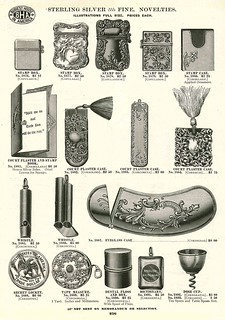 Uncovering numismatic documentation after lying dormant for 120 years is extremely exciting. It certainly makes one question what other
discoveries are out there hidden from public knowledge. In the case of advertisements and catalogs, they are often thrown away…deemed as
unimportant junk mail. A debt of gratitude is owed to all the “pack rats” out there that save what others see as refuse.
Uncovering numismatic documentation after lying dormant for 120 years is extremely exciting. It certainly makes one question what other
discoveries are out there hidden from public knowledge. In the case of advertisements and catalogs, they are often thrown away…deemed as
unimportant junk mail. A debt of gratitude is owed to all the “pack rats” out there that save what others see as refuse.
An important new discovery confirms that these coins were not used for smuggling but were indeed lockets. An ad from an 1896 publication, Busiest House in America (BHA), had one of these coins in print and offered for sale (see Figure 1). The ad pictures the reverse image of a trade dollar and below is the item number 1888 and a six dollar price. Most importantly it is titled as a “secret locket” in the ad. Whether or not there were other companies making them is unknown but BHA called it a secret locket and sold it in a section with sterling silver fine novelties.
For more information on the Token and Medal Society, see:
www.tokenandmedal.org
THE BOOK BAZARRE
2015 WORLD MONEY FAIR TECHNICAL FORUM
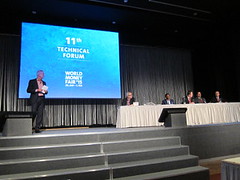 Technicians from 21 companies, 18 talks thematically grouped into 9 units, and countless
representatives of national mints. That was the Thursday afternoon programme at the World Money Fair. Dieter Merkle (Schuler Pressen) and
Thomas Hogenkamp (Spaleck) once again put together a true tour de force showing off the minting industry’s latest innovations. Since each
and every talk demanded undivided attention from its audience, the afternoon programme, which came to an end with a slight delay, left its
listeners exhausted.
Technicians from 21 companies, 18 talks thematically grouped into 9 units, and countless
representatives of national mints. That was the Thursday afternoon programme at the World Money Fair. Dieter Merkle (Schuler Pressen) and
Thomas Hogenkamp (Spaleck) once again put together a true tour de force showing off the minting industry’s latest innovations. Since each
and every talk demanded undivided attention from its audience, the afternoon programme, which came to an end with a slight delay, left its
listeners exhausted.
Ross MacDiarmid, Royal Australian Mint: Silver Blanks
Dr Gerd Wagner, GmbH: hd-pro blanks
Aziya Ibrayeva, Kazakhstan Mint: Study of impact of crystallization parameters (conditions) of the AgCu 92.5 alloy ingots on surface quality of proof quality coin blanks
Stuart Wilson, The Royal Mint: Coin security: The technical challenges of designing and introducing a new, high value, high profile coin

Ronald E. Harrigal, US-Mint: Manufacturing Curved Collector Coins in High Volume
Loic Pollet, Velec and Thabo Nikitseng, South Africa Mint: SA Mint Fully Automatic Packing Line
Markus Schlein / Sack & Kiesselbach, Enhanced Feeding Solutions in the Numismatic Coin Production Area
Hermann Schürer, Economa, New highspeed precision weight checker for blanks and coins
Siemowit Kalukiewicz, Mint of Poland – Most technically advanced 3Dimension coins
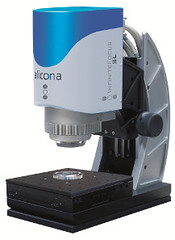

Alfred Gnadenberger, Austrian Mint, and Christian Janko, Alicona, Optical 3 D micro coordinate system for form and roughness measurement and its use in minting
Romain Waidelich, Miba Coating Group, Environmental and working safety aspects of the PVD coating technology vs. galvanic technology
Volker von der Heide, Oerlikon-Metaplas GmbH, The New PVD HI3-Technology – Latest Developments and Potential for Coining Dies.
Robert Newman und Timothy Buch, DELCAM – ArtCAM, Pushing the boundaries of visual security
Ralf Freiberger, Mühlbauer, Coin edge inspection – how to integrate in automatic, high throughput processes
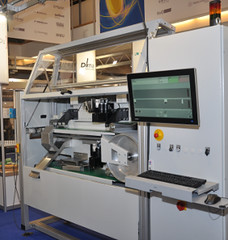
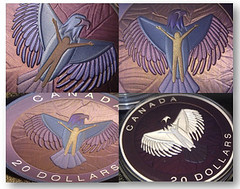
Lutz Büker, InduVis und Simon Watterton, INEA, New solutions in the inspection of blanks
Paolo Mascioli and Massimo Bersani, IPZS, Stress analysis of the working dies
Dr. Xianyao Li, Royal Canadian Mint, Nano technology for minting applications
Paul Smith, Acsys, Modern Coin Design: New Perspectives and Reflections
To read the complete article, see:
Visiting the Technical Forum at the 2015 World Money Fair
(www.coinsweekly.com/en/News/4?&id=3320)
CONFESSIONS OF A GOLD BUYER
I’ve heard stories about old Texas coin shops that sold counterfeit collections to oil millionaires and Mexican construction magnates. These shops used all the old tricks that no longer work: blowing cigar smoke onto silver coins in paper bags to make them look aged, filing and restamping coins with rare dates, and sealing coins in plastic squares so they could be sold as uncirculated. They would assemble a team—a security salesman, say, a corrupt appraiser, and an insurance guy—and they’d sell the coins, overappraise them, provide the security system to guard them, and then steal them back before anyone was the wiser.
Ronnie was an innovator in this world. Around 1980, he opened a coin shop on the corner of Houston and Sixth in downtown Fort Worth, calling it Fort Worth Gold and Silver Exchange. Right about when he opened his shop, there was a rally in metal prices—gold and silver tripled in price between 1978 and 1980. Ronnie, who was already an expert in bullion, realized there was an even better way to make quick cash: buying gold and silver from the public.
Ronnie’s entry into the gold- and silver-buying business came just as the Hunt brothers, from Dallas, nearly succeeded in cornering the market on silver, before they went bankrupt. The news was full of talk about the scarcity of gold and silver and the certainty that precious metals were the only sure-fire get-rich-quick investment. Which, strange though it is, actually makes the average man want to sell his silver and gold.
Ronnie was running full-page “We’ll Pay Cash for Your Old Gold and Silver” ads in the Fort Worth Star-Telegram and the Dallas Morning News, and people drove from all over the metroplex to sell their jewelry. By the time I arrived at the store, we often had lines of thirty, forty, fifty people waiting outside before opening to get to the “buy counter.” Ronnie’s great success was that, once he made a little money from the “buys”—as they’re still called in the industry today—he expanded his coin shop into a full-fledged jewelry store.
But the real money was always in the buys—I’ll explain why in a moment—and the brilliance of Ronnie Cooper’s style was that the luxury jewelers at that time considered themselves morally and socially superior to the practice of buying jewelry from the public (discreetly brokering the private estates of well-established clients was another matter, of course). Ronnie knew the real money was in cheap chains and college rings and old wedding bands, and he understood that the Average Joe didn’t want to walk into a grubby pawnshop to sell his gold: he wanted to be treated with respect.
As soon as you walked into Fort Worth Gold and Silver Exchange and were greeted by one of the beautiful twenty-year-old hostesses who worked part-time at our store while going to college at Texas Christian University only a few miles away, you knew you were going to get the best price for your jewelry. And all were welcome: a homeless guy walking into the store with a paper bag full of gold wedding bands was treated exactly the same as a newly divorced Texas socialite wanting to sell her two-carat D Flawless round.
When they hired you at Fort Worth Gold, for the first month you vacuumed the carpets, changed the ashtrays, restocked the box room, and learned how to steam clean a customer’s jewelry while he or she waited. After you had the flavor of the place, they put you on the buy counter. And this, I realized much later when I ran a store of my own, was perhaps the most ingenious trick in Ronnie’s bag: because the young men and women working the buys were innocents, brand-new to the business, and because they had to get their prices from the old experts who worked desks in the back, we made our buy offers with a sincerity, trustworthiness, and enthusiasm that could never be duplicated by even the cleverest old diamond man. We were too young, too dumb, and too smartly dressed to cheat anyone.
I will never forget the first time I realized we were ripping people off.
To read the complete article, see:
We Buy Broken Gold
(http://laphamsquarterly.org/swindle-fraud/we-buy-broken-gold)
THE ARTIST, THE CONMAN AND THE $15 MILLION FRAUD
On a raw March morning in 2006, a posse of Scotland Yard detectives gathered outside a terraced house near the town of Bolton in one of northern England’s most deprived counties. It is a gloomy property on one end of an arc of fifties-era units; a curve of low-income brick and stucco houses that spill into a sprawling housing estate on the town’s grimy outskirts.
By seven a.m., the five detectives, all part of the Yard’s Art Crime Unit, had sketched out a plan to search the house. Despite a credible tipoff, detectives still wondered if they’d made an embarrassing mistake. It was hard to imagine Number 17 housing a ring of sophisticated art forgers.
But what they discovered shocked even the most seasoned of the squad: Inside was a cottage industry for faking art, where a Svengali-like conman and his vulnerable son churned out forgeries that would rock the London art world.
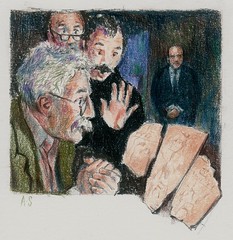 They
were the perfect team, the artist and the conman: a recluse whose unschooled talent and meticulous research produced an astounding array of
forged art and a natural fraudster who saw his son’s gifts and exploited them. Together, Shaun and George Greenhalgh Sr. peddled at least
120 fakes to museums, galleries and auction houses around the world with a potential face value of nearly fifteen million dollars. Olive,
George Sr.’s wife and the matriarch of the Greenhalgh clan, helped plot the backstories.
They
were the perfect team, the artist and the conman: a recluse whose unschooled talent and meticulous research produced an astounding array of
forged art and a natural fraudster who saw his son’s gifts and exploited them. Together, Shaun and George Greenhalgh Sr. peddled at least
120 fakes to museums, galleries and auction houses around the world with a potential face value of nearly fifteen million dollars. Olive,
George Sr.’s wife and the matriarch of the Greenhalgh clan, helped plot the backstories.
Dealings began in 1989, when George Sr., then in his late sixties, hawked his son’s first fake, kicking off a family forgery business that would flourish for nearly twenty years.
It was Shaun who researched missing masterpieces, poring over historical details and technical descriptions. Working from old photographs or drawings he could switch artistic mediums with amazing dexterity, easily moving from an Anglo-Saxon reliquary to nineteenth-century watercolors. He tried his hand at L.S. Lowry, Henry Moore, Man Ray, Constantin Brâncuși and Otto Dix, the variance of his work prompting Scotland Yard to name him the most diverse forger in history. George Sr. in particular had a knack for learning from his mistakes. If a fake was rejected, he’d work out a better pitch and more convincing storyline. As the Crown Prosecution Service put it: “the defendants were persistent, taking failure in their stride before turning to new fakes.”
The duo struck pay dirt in 1991 when two American buyers paid $160,000 for a Roman silver tray, the Risley Park Lanx. The piece was later put on display at the British Museum as a cast of the original Lanx.
Business thrived: a Samuel Peploe still life sold for $32,000; a bust of Thomas Jefferson sold at Sotheby's for $77,000; a Barbara Hepworth terracotta goose was bought by the Henry Moore Institute for $4,800; and the Chicago Art Institute picked up a Gauguin sculpture for $125,000. All were fakes.
Then in 2003, the Greenhalghs hit the jackpot: a $700,000 sale to the local Bolton Museum. It was a clever combination of Shaun’s delicate craftsmanship and George’s inventive record of ownership — known in the art world as provenance — that convinced Egyptologists they had discovered a rare artwork dating back more than three thousand years. The British Museum and Christie’s, which handled the sale, agreed. The twenty-one-inch alabaster figure, known as the Amarna Princess, was Shaun’s masterwork, yet he later claimed he’d carved it in just three weeks. Significantly, the translucent statue wasn’t a copy created to look like an original. This time Shaun was working fresh, creating his own vision of an Egyptian royal princess with stunning results.
It was the largest-running forgery scam in recent history, and police estimate it netted the Greenhalghs about $1.6 million. They had over $600,000 sitting in bank accounts, but the only visible sign of their windfall was a new Ford Focus sitting outside the house. Indeed, by the time Scotland Yard arrived in 2006, little had changed in the more than thirty years the family had lived on the estate. Shaun still shared a small bedroom with his brother, an elderly aunt and his mother. Neighbors called them frugal, reclusive, peculiar, even a bit forlorn: Five adults crowded into a dingy three-bedroom council house.
To read the complete article, see:
THE ARTIST, THE CONMAN AND THE $15 MILLION FRAUD
(http://narrative.ly/pulp-non-fiction/artist-conman-and-15-million-fraud/)
THE BOOK BAZARRE
QUERY: GEORGETOWN OBSOLETE BANKNOTE INFO SOUGHT
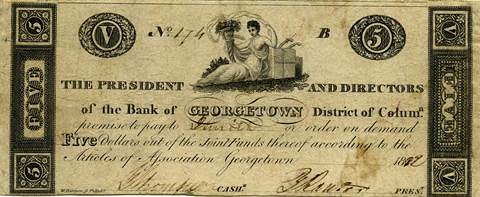
Haxby DC-100-G8
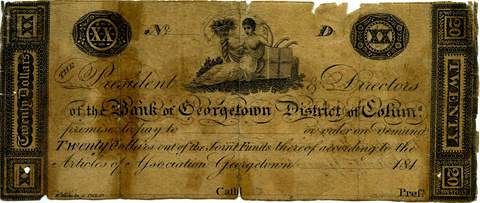
Haxby DC-100-G12
I was wondering if our readers might be able to provide some insight on these two W. Harrison, Philad notes.
The wording of these two notes is for an association issue – “out of joint funds” etc. No early banks were chartered in Georgetown with this name and I have not found any partnership agreements for any bank that used this title, though there is always the possibility that this was an early title that was subsequently changed.
Of the four likely candidates for “real” Georgetown banks (1805-1820 range), only two show using Harrison for notes in Haxby.
1. Union Bank of Georgetown used Harrison and no association notes have been found. 1809 published partnership agreement used the Union bank name, however, (Chartered 1811)
2. Central Bank of Georgetown also had Harrison notes. But published partnership agreement (July 1815 - chartered March 1817 used the Central Bank name
3. Farmers and Mechanics Bank of Georgetown never appeared to use Harrison and the January 1814 partnership agreement (chartered March 1817) used the F&M name, in any case.
4. Bank of Columbia – no sign of Harrison notes but anyway, chartered too early for Harrison (Dec 1793)
So, assuming these are from altered plates, does anyone recognize this Harrison design from elsewhere? Or other ideas?
NEW IRAN BANKNOTE REMOVES NUCLEAR SYMBOLS
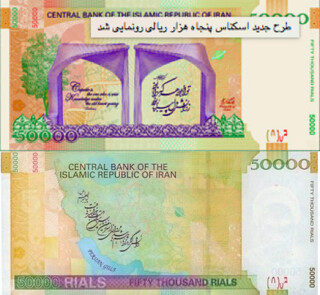 The Central Bank of Iran unveiled a new 50,000 Rial bank note on March 2, in what has been deemed a “political move” by some observers. The
new note, which was unveiled with members of the University of Tehran's faculty on March 4, 2015, replaces the nuclear symbols that
covered a map of Iran with the gates of the University of Tehran.
The Central Bank of Iran unveiled a new 50,000 Rial bank note on March 2, in what has been deemed a “political move” by some observers. The
new note, which was unveiled with members of the University of Tehran's faculty on March 4, 2015, replaces the nuclear symbols that
covered a map of Iran with the gates of the University of Tehran.
At the moment, the Iranian government is in negotiations over its nuclear program with the P5+1 in Lausanne, Switzerland. The deadline for the negotiations are set for the end of March. A nuclear deal will determine the level of Iran's nuclear enrichment in addition to how sanctions will be lifted from Iran.
To read the complete article, see:
New Iranian Bank
Note Replaces Nuclear Symbols with University Gates
(http://globalvoicesonline.org/2015/03/18/new-iranian-bank-note-replaces-nuclear-symbols-with-university-gates/)
NEW 20 EURO PROMOTED WITH TETRIS GAME
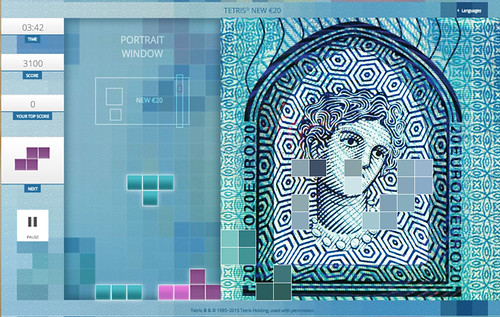
If there's one thing that kids love more than Tetris, it's learning about the security features built into new banknotes. Thankfully, the folks at the European Central Bank have devised a way to combine both of those pursuits in the form of Tetris New 20 Euro. The browser-based title is a variation on the block-dropping classic that sees you learn security facts about the new 20 Euro note as a reward for finishing a level. For instance, did you know that the portrait of Europa (pictured) becomes a transparent hologram if you hold the note up to the light? Put it this way: with trivia this good, no-one will be able to resist you hitting on them at the club this weekend
To read the complete article, see:
How do you promote a new banknote? With
'Tetris,' of course (www.engadget.com/2015/03/20/european-central-bank-new-euro-tetris/)

NUMISMATICA GENEVENSIS NOVEMBER 2014 SALE SUMMARY
A Coined History of the Islamic World
On 24 and 25 November, 2014, Numismatica Genevensis conducted an auction at Geneva. What made this auction catalog special: large parts of Islamic history can be reconstructed by a look at the coins offered there.
Although it was no more than 92 lots they nevertheless illustrated 13 centuries of Islamic history, from humble beginnings in the late 7th century until the great empires of the past.
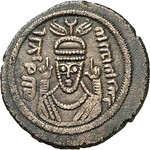
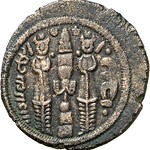
((1. Anonymous. Copper pashiz, undated, around 72-95 AH (= 691-715), Istakhr. Numismatica Genevensis 8 (2014), 219. Estimate: 3,000 CHF. Hammer price: 20,000 CHF.))
Coins are the earliest evidence of an Islamic identity that has come down to us. Yet we have to know how to interpret the coins in order to grasp their historical message. A case in point is this copper pashiz that has been minted at some point between 691 and 715. It depicts a Sassanid ruler with both index fingers raised, pointing upwards. This gesture was understood by contemporaries. It represented the submission to Allah and was part of the confession of faith of a proselyte.
This coin takes us back to the time of the first Arabic expansion: in 636, the warriors of Umar sent Sa’ad ibn Abu Waqqa conquered the Sassanid Empire in the aftermath of the Battle of al-Qadisiyyah. They became the new rulers of a rich country where the merchants of Mesopotamia engaged in business with the entire then known world. Via the Silk Road, Sassanid coins made their way to China and the icy northern parts of Scandinavia.
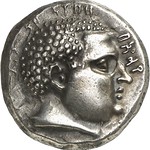
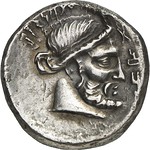
((2. Yad’ab Dhubyan Yuhargib, around 155-135 B. C. Tetradrachm, undated. Numismatica Genevensis 8 (2014), 274. Estimate: 50,000 CHF. Hammer price: 135,000 CHF.))
That the Arab peoples had an age-old tradition of minting coins and knew how to use this medium is evidenced by a unique tetradrachm that was made around the middle of the 2nd century B. C. It shows two male portraits we have not yet identified for sure.
What is clear, however, is the fact that the new, Arab rulers of the Sassanid Empire knew how important coinage was for a working economy. Thus, they continued minting those coins their new subjects were used to. Yet they added little, though clearly visible, hints at Ahura Mazda being replaced by Allah as supreme deity of the empire.
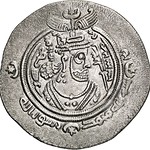
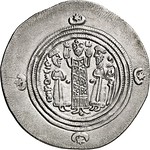
((3. Bishr bin Marwan, AH 73-75 (692-694), drachm AH 75 (694), Basra. Numismatica Genevensis 8 (2014), 221. Estimate: 20,000 CHF. Hammer price: 62,000 CHF.))
The zoroastrian fire altar of the traditional coins of the Sassanid rulers was eliminated by the new rulers and substituted by a clear religious statement: at the spot where the fire altar used to have been, a drachm of Bishr bin Marwan depicts the caliph in adoration, raising his hands to the sky. On both sides – just like the guards in front of the fire altar earlier – there are two persons bearing witness to his prayer.
Bishr bin Marwan was the brother of the great Caliph ’Abd al-Malik bin Marwan who planned to carry out a major monetary reform in his huge empire…
((4. Byzantine solidus of Heraclius with his sons Heraclius Constantine and Heraclonas, 632-641. Numismatica Genevensis 8 (2014), 226.)) Back then, ’Abd al-Malik ruled Mesopotamia, Syria, Palestine and Egypt. Many of these territories used to have been controlled by the Byzantines. Byzantine gold coins were circulating everywhere. Featuring crosses on both sides these solidi propagated a message the Umayyad caliphs intended to oppose.
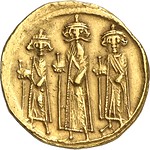

((5. Umayyad coinage. Undated Arab-Byzantine solidus, around 60-72 AH (= 679-691). Numismatica Genevensis 8 (2014), 226. Estimate: 75,000 CHF. Hammer price: 200,000 CHF.))
It was the founder of the Umayyad Dynasty, the first Caliph Mu’awiya, who, in the aftermath of the conquest of Syria, needed a surrogate for the Byzantine gold coins that circulated in that area. The first Islamic gold coinage was the result. These coins imitated the Byzantine models, albeit with a major difference: the Christian symbols, the crosses on both crown and reverse, became religiously inconspicuous pillars.
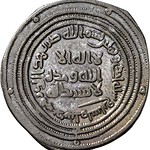
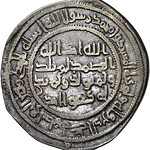
((6. ’Abd al-Malik bin Marwan, 68-86 AH (= 685-705). Dirham, 81 AH (= 700), Dasht Maysan. Numismatica Genevensis 8 (2014), 230. Estimate: 8,000 CHF. Hammer price: 9,500 CHF.))
’Abd al-Malik went even further. He had all Persian and Byzantine coins that were used in his empire replaced by his own coinage. In the year 74 AH (= 695), he issued gold coins with a completely new imagery, that went down in monetary history as the ‘standing caliph’. He soon realized, though, that this was not a good choice. It appeared far too similar to the Byzantine model with the standing ruler. The new religion needed a completely new and unparalleled motif. Consequently, dinars and dirhams were produced that exhibited nothing else but an inscription with which the ruler expressed his Islamic faith.
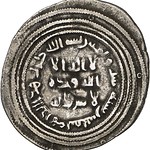

((7. ’Abd al-Malik bin Marwan or his successor. Dirham 86 AH (= 705), Tiflis. Numismatica Genevensis 8 (2014), 232. Estimate: 40,000 CHF. Hammer price: 55,000 CHF.))
The silver dirhams soon came into use everywhere merchants dealt with precious goods. Also they were produced in those areas where soldiers of the Umayyad army received their pay. This rare specimen was struck in Tiflis / Georgia.
((8. Sulayman, 96-99 AH (= 715-717). Dirham, 97 AH (= 715-716), al-Hind. Numismatica Genevensis 8 (2014), 238. Estimate: 150,000 CHF. Hammer price: 540,000 CHF.))
Umayyad dirhams were produced as far away as India. This extremely rare item harks back to an expedition conducted by the important general Muhammad bin al-Qasim. He conquered the Indus Valley and successfully installed a firm control over the territory. When the caliph died in Damascus, though, Muhammad bin al-Quasim as his favorite was stripped of his office by the caliph’s successor and executed. New generals controlled the territory. Under their rule, this unique coin was made whose place of minting is given, al-Hind. This means that the coin was struck in the area east of the Indus, perhaps in the important city of Multan, located in modern Pakistan.
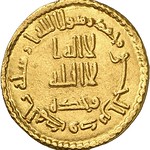
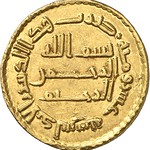
((9. Hisham, 150-125 AH (= 724-743). Dinar, 110 AH (= 728/9), al-Andalus. Numimatica Genevensis 8 (2014), 246. Estimate: 30,000 CHF. Hammer price: 80,000 CHF.))
Likewise the coins produced in Andalusia were not marked by the Cordoba Mint but were added the lettering al-Andalus.
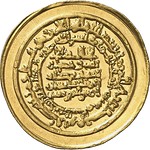
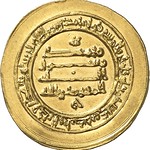
((10. al-Muqtadir, 295-320 AH (= 908-932). Heavy dinar, 303 AH (= 915-916), Madinat al-Salam (= Baghdad). Numismatica Genevensis 8 (2014), 257. Estimate: 15,000 CHF. Hammer price: 42,000 CHF.))
The founder of the Abbasid Dynasty descended from Mohammed’s youngest uncle, Abbas ibn Abd al Muttalib. The Abbasids therefore demanded that a caliph had to be blood-related to Mohammed, a condition the Umayyads did not fulfill. The power of the Umayyads dwindled constantly, and in 145 AH (= 762), the Abbasids moved the caliph’s residence to Baghdad. Gorgeous Baghdad stands for Islam’s golden age, for universities, public hospitals and scientific progress. Baghdad became an international commercial hub frequented by ambassadors from all around the world. Even Charlemagne sent diplomats and gifts which Harun ar-Raschid reciprocated with the famous elephant called Abul Abbas. Less important rulers were honored with coins as presents, just like this heavy dinar from 303. With its broad planchet, the fine striking and the heavy weight of 5.14 g it was a worthy gift for a visitor of high rank.
((11. al-Mutawakkil, 232-247 AH (= 847-861). Dinar, 234 AH (= 848-849), Mecca. Numismatica Genevensis 8 (2014), 276. Estimate: 30,000 CHF. Hammer price: 32,000 CHF.))
Only a few coins of the Abbasids were minted in Mecca. They, too, are very likely to have served ceremonial purposes.
((12. Umar bin Muhammad, 357-358 AH (= 967-968). Dinar, 357 AH (= 968), Oman. Numismatica Genevensis 8 (2014), 280. Estimate: 125,000 CHF. Hammer price: 130,000 CHF.))
It was almost impossible for the Abbasids to control all the rising local leaders on the fringes of the empire. One of these was Ali bin Ahmad in Oman. He hedged his bets, referred to rulers of the Buyid Dynasty in Iran on his coins as well as the representatives of the council of elders of the Qarmatians of Bahrain and the Abbasid caliphs. The loyalties and hence the names stated on the coins changed according to the political situation. This specimen, for instance, skips the Abbasid caliph.
The fact that many minting authorities name those rulers they acknowledged in their legends renders coins a very important tool for the reconstruction of the history of those regions and periods of which only few written sources have survived.
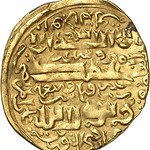
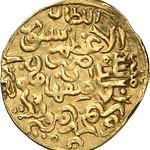
((13. Timur (Tamerlan), 771-807 AH (= 1370-1405). Dinar, 786 AH (= 1384), Isfahan. Numismatica Genevensis 8 (2014), 291. Estimate: 20,000 CHF. Hammer price: 42,000 CHF.))
Timur, the Emir of Transoxania, came of humble stock, to become the ruler of most of Central Asia. His coins take account of his origins in that they only rarely state his name. Instead, he issued coins in the name of the ruler of the Chagatai Khanate who was entirely deprived of his power back then. Timur’s name appears on only a handful of coins. This unique specimen is the largest denomination carrying his name.
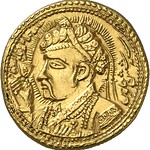
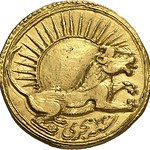
((14. Nur-Ud-Din Muhammad Jahangir, 1014-1037 AH (= 1605-1628). Mohur 1020 AH (= 1611). Numismatica Genevensis 8 (2014), 307. Estimate: 100,000 CHF. Hammer price: 200,000 CHF.))
Jahangir, son of the great Mughal ruler Akbar, was the first to issue coins bearing a portrait again, after centuries of coins that had lacked any figural representation. The impressive specimen depicts the ruler to the left, wearing an elaborate garment, his turban set in an aureole, matching his portrait on extant paintings.
This emission was produced solely for representational purposes. As the great number of written sources on the Mughal Empire reveal, this coin was given exclusively to Jahangir’s favorites who attached it as an agraffe to their turban or their garment, in the same way as a protective amulet was worn.
The Islamic coinage offers a wealth of historically highly interesting coins that are an indispensable primary source on Muslim history.
To visit the Numismatica Genevensis web site, see:
www.ngsa.ch
NEW YORK'S FIRST BANK ROBBERY
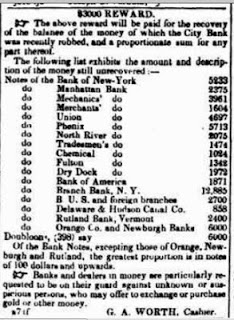 When workers arrived at the City Bank at 52 Wall Street* on Monday, March 21, 1831, they were in for a rude shock. Sometime over the
weekend—probably the evening of March 19 or the early morning hours of March 20—the bank had been robbed of $245,000 in bank notes and
Spanish doubloons. This was New York’s first-ever bank heist.
When workers arrived at the City Bank at 52 Wall Street* on Monday, March 21, 1831, they were in for a rude shock. Sometime over the
weekend—probably the evening of March 19 or the early morning hours of March 20—the bank had been robbed of $245,000 in bank notes and
Spanish doubloons. This was New York’s first-ever bank heist.
Though suspicion immediately fell on workers at the bank, the police had little time to investigate the employees before they received a tip from Mr. Bangs, the proprietor of a “respectable private boarding house” (according to the New-York Evening Post) who was leery of his newest tenant.
On the Monday following the robbery, a man calling himself Mr. Jones had arrived at Mr. Bangs's boarding house on Elm Street with three small trunks, asking for a private room in which to write. He paid for the room in advance. After a few days, the landlord became suspicious over Mr. Jones’s apparent anxiety, especially concerning the contents of his trunks. When one of the trunks disappeared, Mr. Bangs contacted the police. The police—seemingly without probable cause or a warrant—picked the locks of the two remaining trunks and found bank notes they could positively identify as being from the City Bank robbery.
When Mr. Jones returned to the boarding house, he was promptly arrested. The robber was soon discovered to be Edward Smith, who lived on Division Street with his wife and two children and ran a shoe store. He was well-known to police, having been arrested for a store robbery in Brooklyn.
Of the $245, 000, only about $176,000 was recovered from Smith. The bank soon began advertising for people to keep an eye out for the other bank notes (and the Spanish doubloons). One apparent accomplice was arrested in Philadelphia in April when some of the missing bank notes were identified on his person. But it is unclear if the remainder of the money was ever recovered or if that man was, indeed, part of the robbery.
A jury found Edward Smith guilty in a one-day trial (that one day included jury selection, testimony, and deliberations) and he was sentenced to five years hard labor in Sing-Sing prison.
To read the complete article, see:
New York's First Bank Robbery
(http://blog.insidetheapple.net/2012/03/new-yorks-first-bank-robbery.html)
DESIGNER COIN BANKS


Not all coin banks are piggy banks intended to encourage children to save. As a professional organizer, I became interested in these products when I saw clients with coins spilling all over the nightstand or dresser top. Sure, they could just put those coins in a simple jar, but they might enjoy using a well-designed coin bank more.
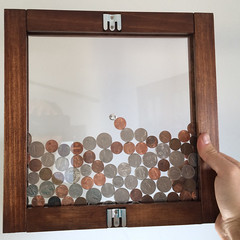 Some
users may have limited space for a coin bank on a nightstand, dresser or other flat surface; such users might appreciate a design like the
hanging vertical coin banks from Revol Design, available in three sizes to meet varying storage needs and space limitations. The coins are
emptied out by removing the magnetic latch on the bottom.
Some
users may have limited space for a coin bank on a nightstand, dresser or other flat surface; such users might appreciate a design like the
hanging vertical coin banks from Revol Design, available in three sizes to meet varying storage needs and space limitations. The coins are
emptied out by removing the magnetic latch on the bottom.
The banks were designed for U.S. coins, with "two sheets of clear acrylic spaced precisely apart to allow the thickest coins, nickels, to fit while preventing the thinnest coins, dimes, from overlapping." However, there is also a euro-compatible version, and the bank will work some other currencies, too. This is a good reminder of how international differences need to be accounted for in product designs intended for a global audience.
To read the complete article, see:
Coin Banks: Organizing the Spare Change
(www.core77.com/posts/32841/Coin-Banks-Organizing-the-Spare-Change)
FEATURED WEB PAGE: THE ANS COLLECTION AT HATHITRUST
This week's Featured Web Page is suggested by Len Augsburger. He writes:The American Journal of Numismatics, series I, is now completely online at HathiTrust – all 53 volumes. AJN series 2, through vol. 20 (2008), are also all there. Heretofore we’ve only had scattered issues on Google Books and Internet Archive.
http://babel.hathitrust.org/cgi/mb?a=listis;c=1850525919
